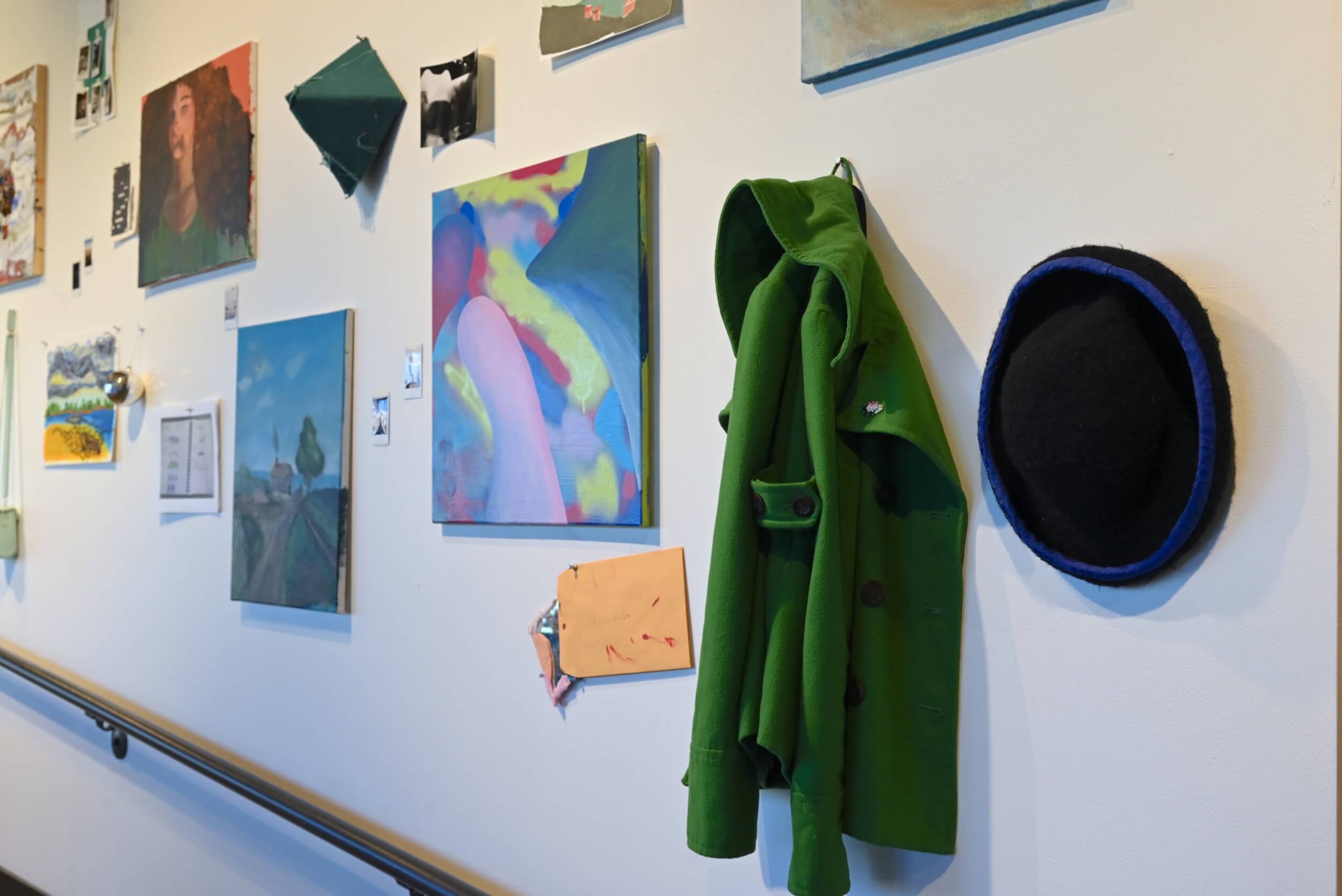At their most fundamental level, Colorado Academy’s Advanced Studies and Research (ASR) courses are about achieving more—more than is possible in some of the Advanced Placement offerings they have replaced, more even than in the Upper School’s many other Honors courses. The ASR program’s mission statement asserts, “Excellence is not defined by multiple-choice tests or by the weight of a textbook, but rather by the depth with which students are able to explore, ignite, and transform new knowledge. ASR courses allow students to have more agency, go deeper, engage in knowledge production, and pursue multidisciplinary questions in the real world.”
Head of School Dr. Mike Davis has said of this move toward innovative, college-level learning experiences, “The kind of programmatic evolution that ASR represents is at the heart of CA’s mission. Our students are curious, and classes that are geared towards preparing students for cumulative AP exams rarely leave breathing room for the kind of deep exploration that we want to elevate schoolwide.”
If there is one ASR course that perhaps puts “deeply exploring“ on a higher pedestal than any other, it is Senior Portfolio, a cornerstone in the CA Visual Arts Department for more than 30 years. Earning the ASR designation in 2023 alongside advanced new offerings in English, Social Studies, Computer Science, and Music departments, the yearlong, by-application-only course caps an established, six-trimester sequence during which CA artists develop their understanding, ideas, and techniques in their Junior year on the way toward creating a body of work for a full-fledged exhibition in their Senior year in the main gallery of the Ponzio Arts Center.
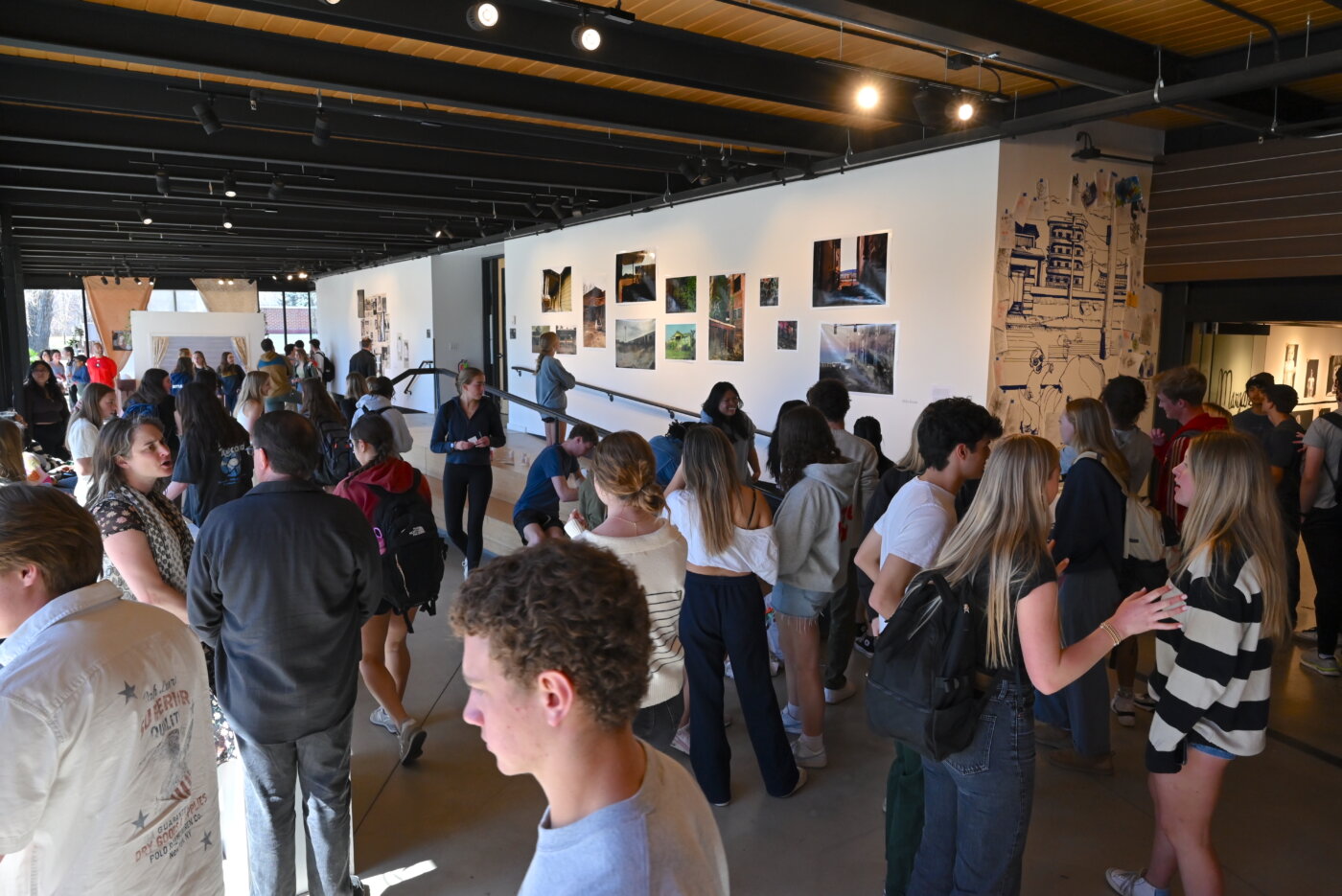
“Senior Portfolio was an ASR course before we ever defined the ASR program,” says Stashia Taylor, Senior Instructor in studio and digital art. “It has always been about teaching students how to be independent artists—from researching the history of a genre and learning about current movements to analyzing that landscape and figuring out how it informs their own practice.”
The goal of Senior Portfolio, Taylor makes clear, is to prepare students to confidently pursue art—or any other discipline—in the real world, where all ASR courses are targeted. “What that looks like as these students leave us is that they are comfortable owning what they want to know, and they are equipped with critical habits that will guide them to find answers even when none are readily available.”
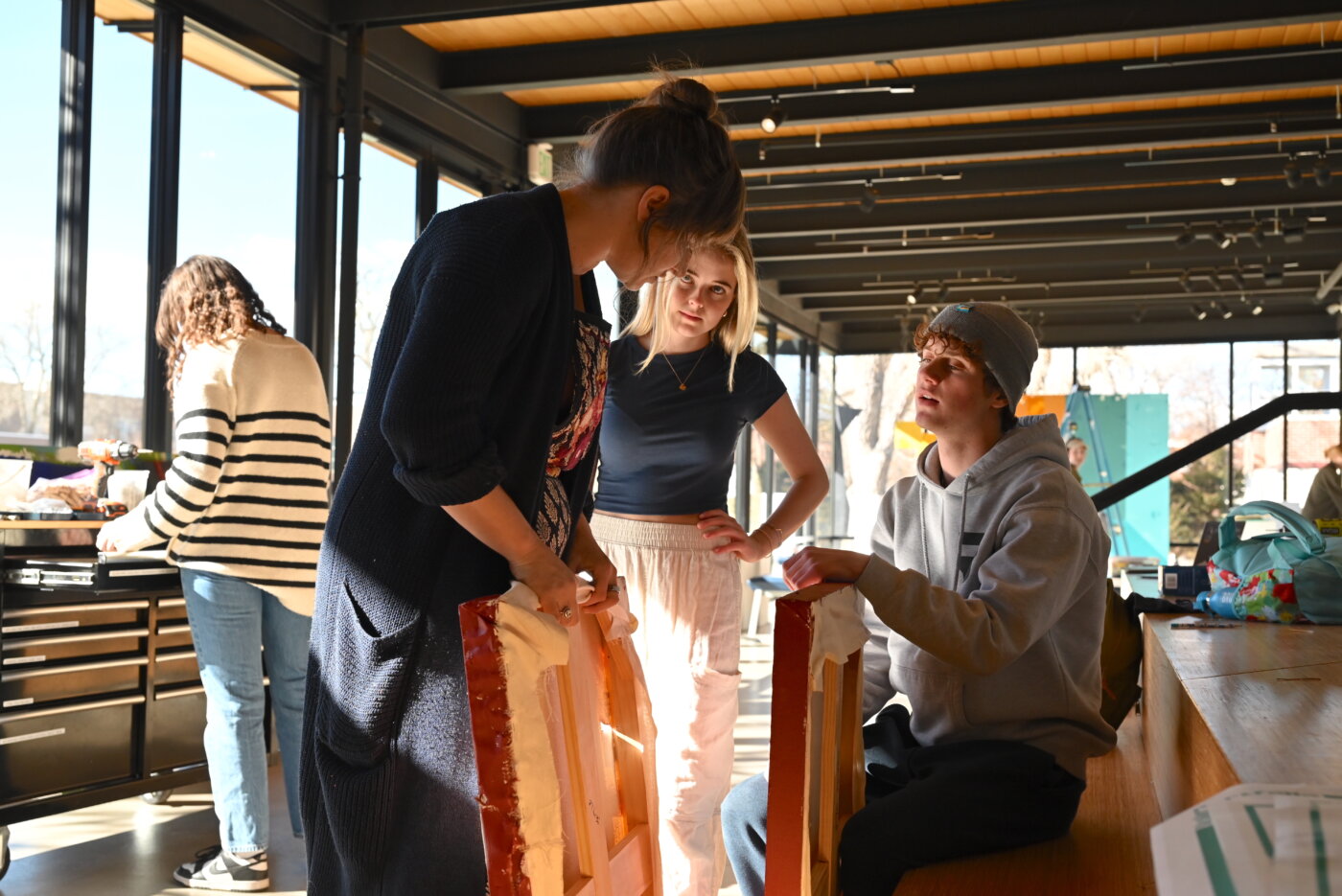
Most exciting is that the actual outcome for each individual student is almost always unknown beforehand, continues Taylor. The collection of artworks that surfaces by the end of Senior year emerges only through a complex, ever-changing journey whose multidisciplinary nature is core to the very definition of the ASR concept.
Throughout the months of preparation leading up to the series of Senior Portfolio exhibitions each spring, explains photography instructor Karen Donald, “Our artists are looking not just at how they make, but at why they make, how do they present, who is their art for, what do they want to communicate, and how might the work be interpreted?”
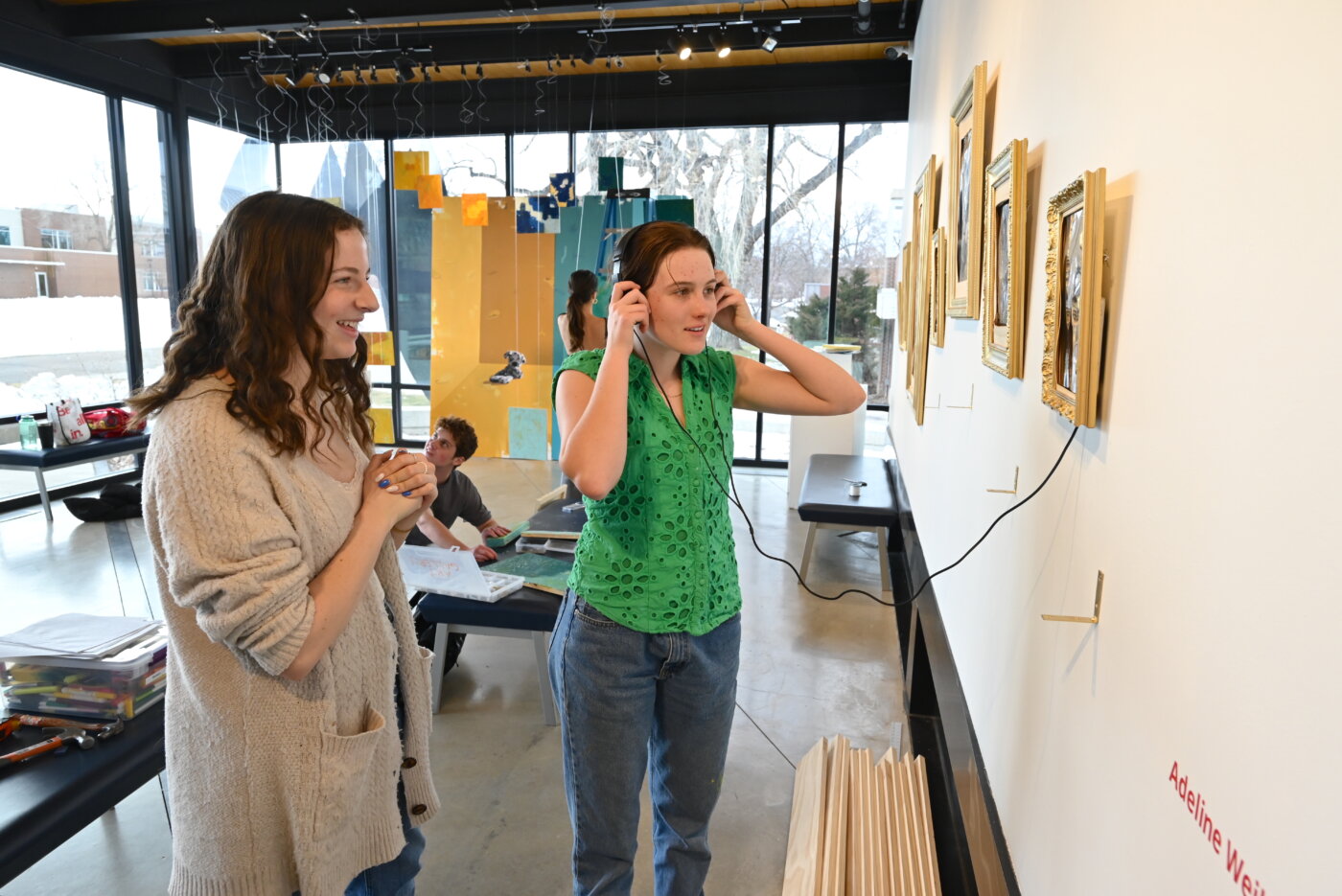
Making sense of art, then, means making sense of themselves and making sense of how their efforts fit alongside those of the fellow Senior artists they’re exhibiting next to. “It’s a lot of teaching intention,” elaborates Taylor.
During their Senior year, she recounts, artists must not only define, defend, and execute on their vision, but they must also work with their peers to create the marketing for and curate each themed Portfolio show, aid in mounting and breaking down the series of exhibitions, and then, after it’s all over, determine how they will forge wider connections that bring new knowledge to the CA community and potentially shape their college careers and beyond.
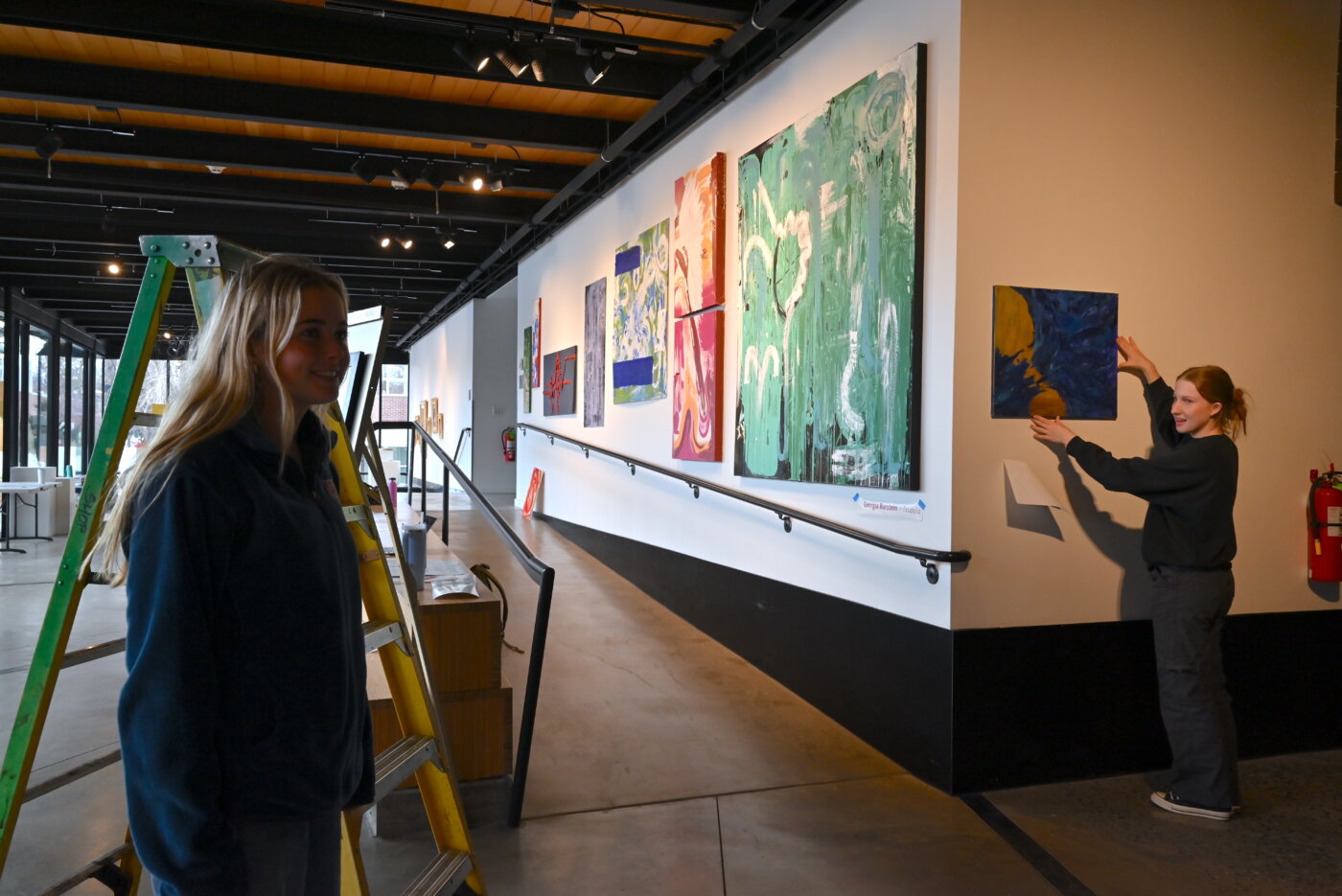
“The growth we witness through this process is incredible,” attests ceramics and 3D visual art instructor Alecia Maher. “From their Junior year, when they’re just generating ideas and feeling their way, to their Senior year, when they start to lean into their own discoveries and push forward with confidence—it’s inspiring for me as a teacher and an artist.”
And it’s not just creative growth, Maher insists. “They are in the studio spaces together week in and week out, stressing about their work and their ideas, supporting each other, getting feedback, and maybe even pivoting in a new direction in the middle of their process. Ultimately, they’re learning what it means to work collaboratively with other creatives, and building relationships that will last forever.”
Big questions
In their artist statements, the creators in the Class of 2024 who exhibited their work in four Senior Portfolio shows this spring explain the significance of the deep reflection the program encourages and the profound impact it makes in their lives.
“When I started brainstorming for this Portfolio show, I found myself reflecting on my past 17 years at CA,” relates painter Ellen Clowes. “I thought about how my entire life had revolved around CA, and I questioned who I would be without the friends, teachers, and style of education I had known for so long. How could I be myself without such a prominent part of my life? My future was also blurry and, in fact, still is. What do I want to accomplish in the future? Where will I be a year from now?”
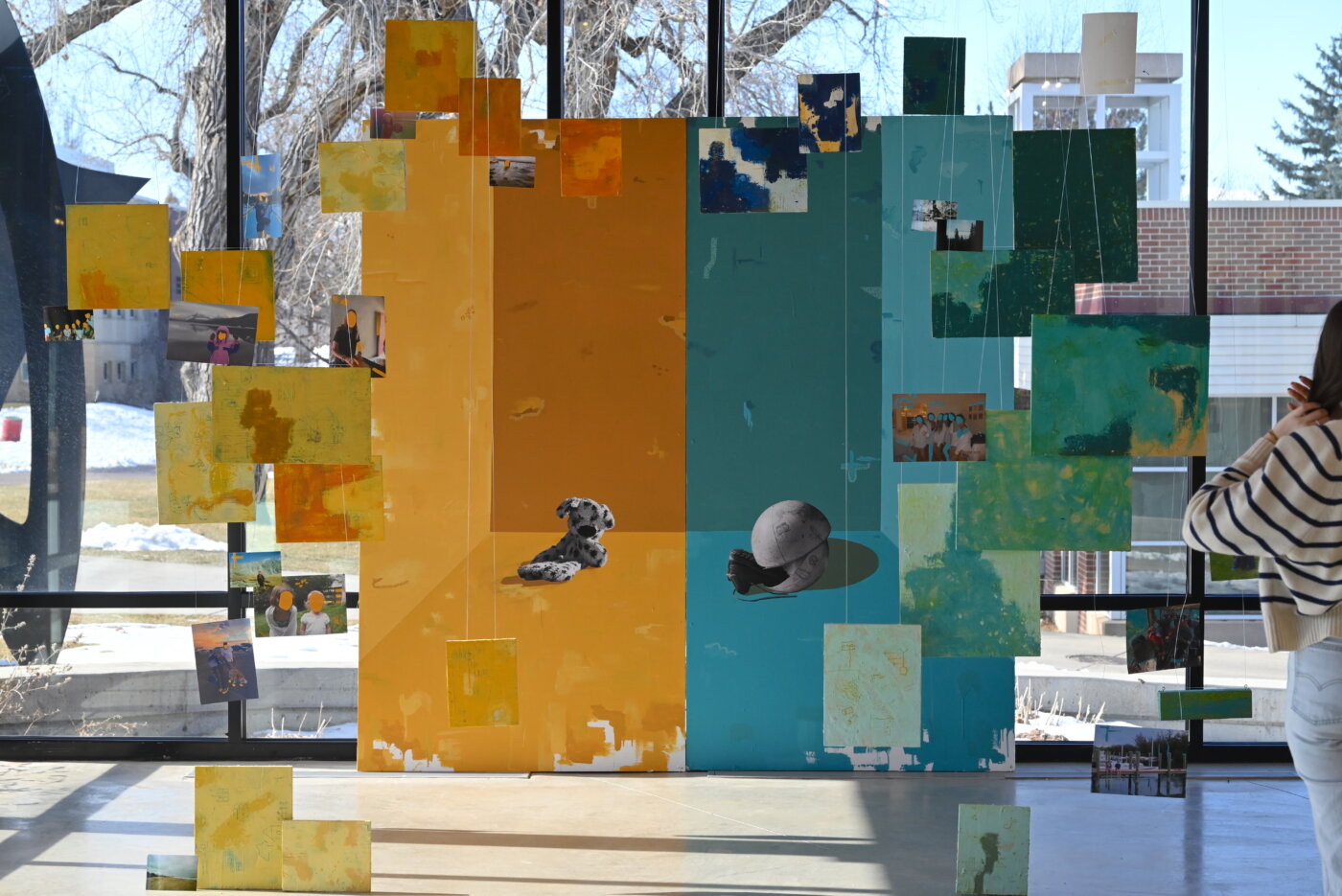
Similarly, multimedia artist Alex Miramontes asks poetically, “What are we? Are we the people that we dance and sing and laugh with? Or, are we all the places where we dance? Are we the streets who with their braggadocious presence, shine their loud lights into our humble eyes? Are we the back alleys who from the shadows listen to our untold secrets? Are we the front porch sidewalk that burns away wet pool footsteps? Are we the things that we do for others? The uncomfortable wait as we hold open doors? Or, are we the things we do for ourselves?”
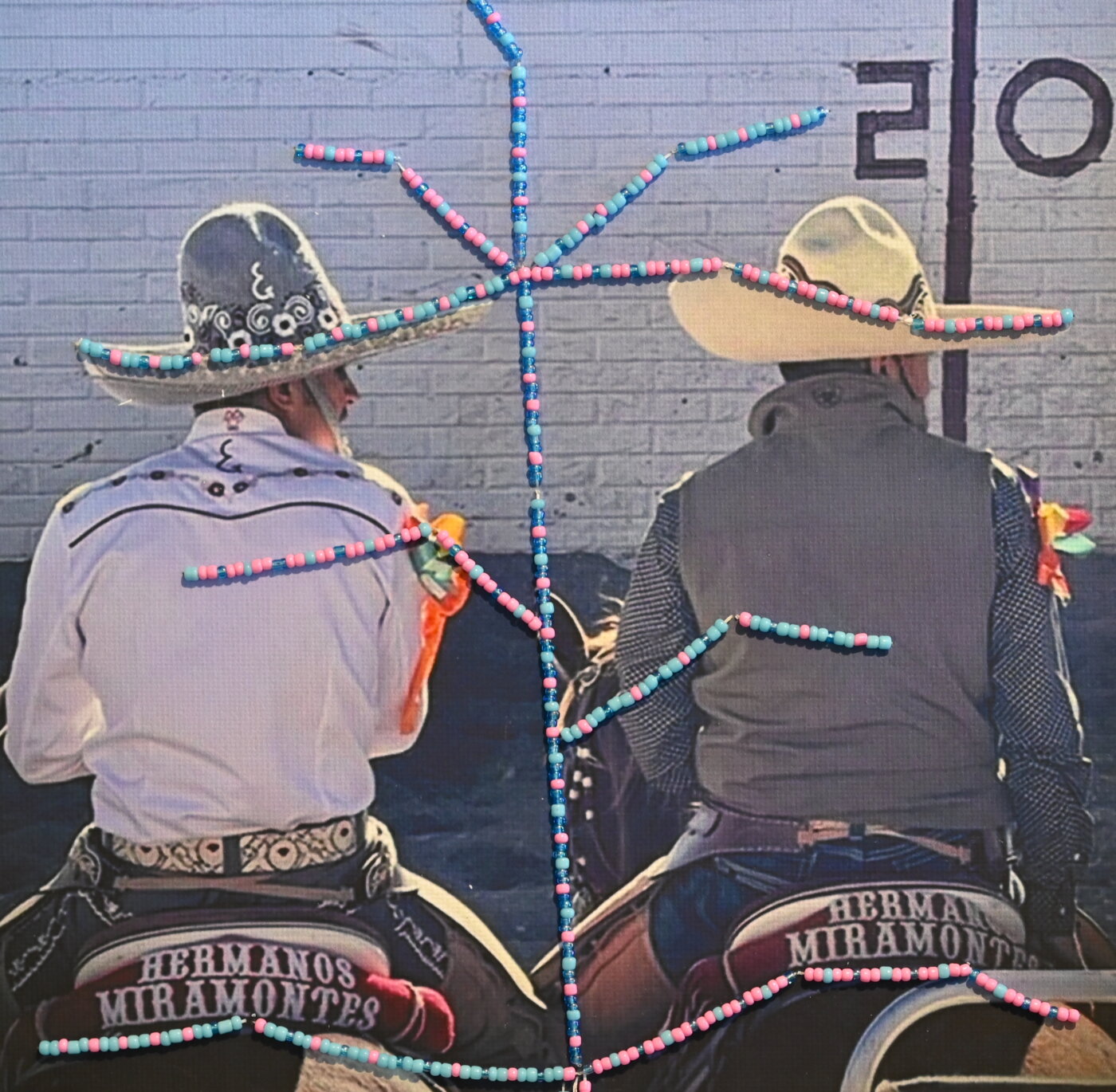
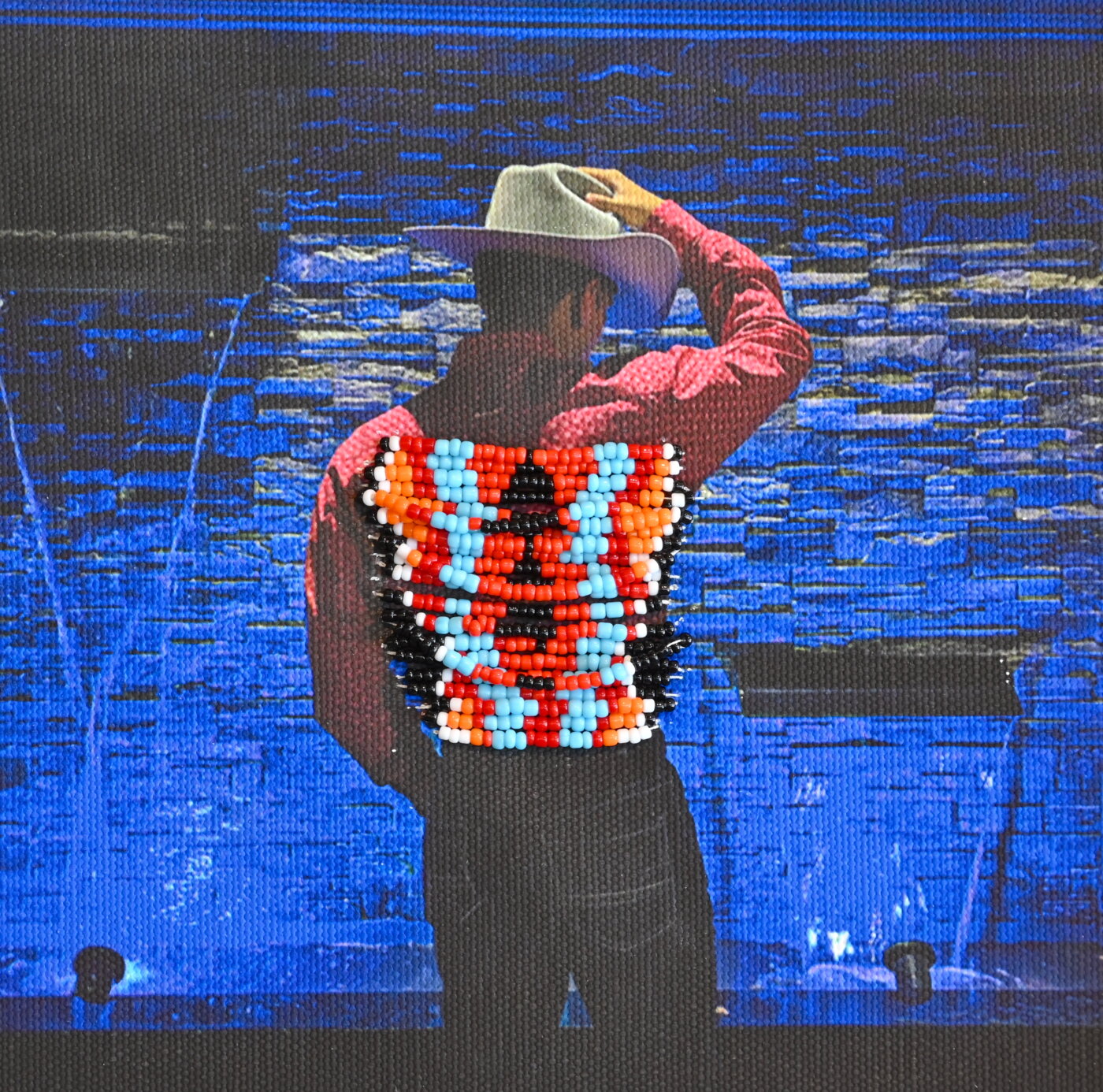
Georgia Burstein also found that the Portfolio approach raised important questions. “Yes, it is easy to throw paint on a canvas and create works that appear haphazard, but it is a demanding process to become emotionally involved in art that looks ‘easy’ to create. Placing a piece of your identity that could be deemed as superficial on display for the world to judge requires a mental fortitude that I have been pursuing since beginning my artistic process. I struggle with the impact of judgment, even as my Portfolio is complete, but what I have come to realize is that by embracing the unexpected or atypical art, I have found a deeper understanding of what it is to be vulnerable.”
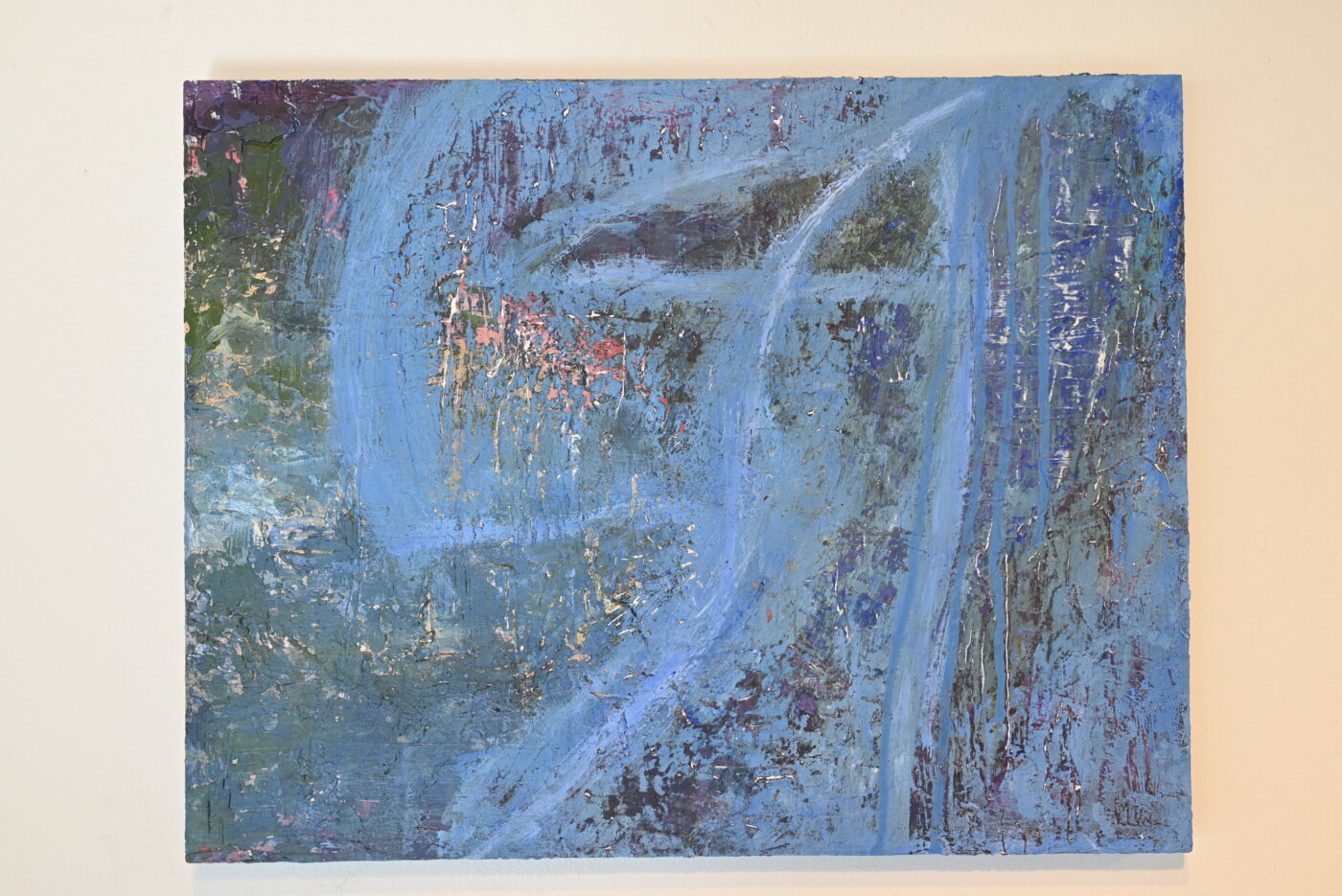
And while working on her collection of black-and-white photographs, Allie Weil discovered a new way to express her vision. “As I started my Senior year, I began to reflect on who I am, who the people I surround myself with are, and what inspires me. In the end, I wanted to portray the impact that the most important people in my life have had on me through my portraiture. This was never going to be an easy feat. Taking a portrait of something as abstract as human impact was hard. So, I turned to the only other thing that allows me to feel completely free—music.”
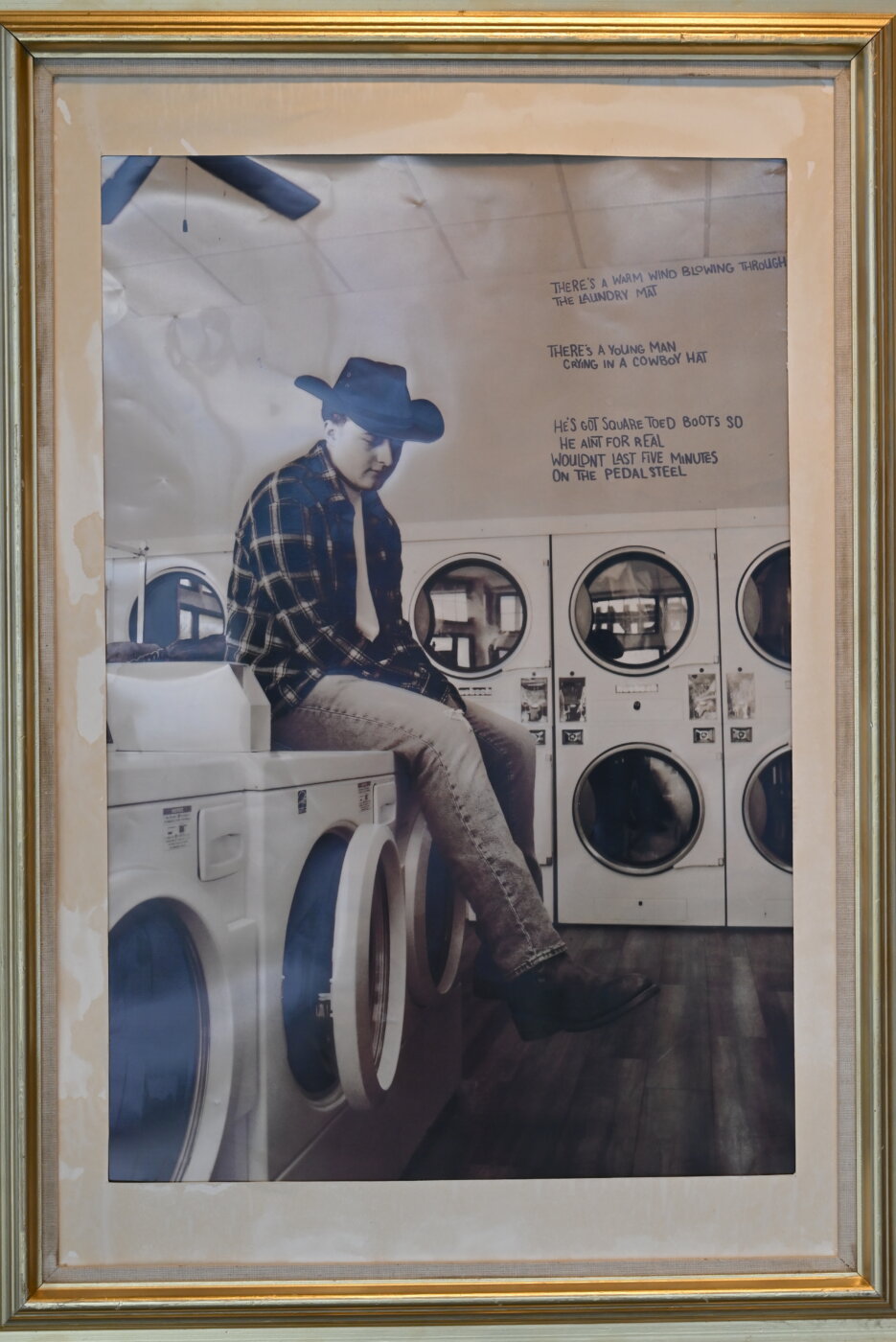
Exploring ideas
The Portfolio process inspired Carson Flottman to tackle essential ideas through multimedia installations. “Throughout my work over the past three trimesters I grappled with the concept of insignificance. One aspect of this is how small the human race is in the grand scheme of the universe and time. Often in society we believe that we have a bigger impact than we do. I want my work to almost bring people back to earth and realize that we are only here for a short period of time and that time should be enjoyed rather than taken for granted and dictated by negative emotions.”
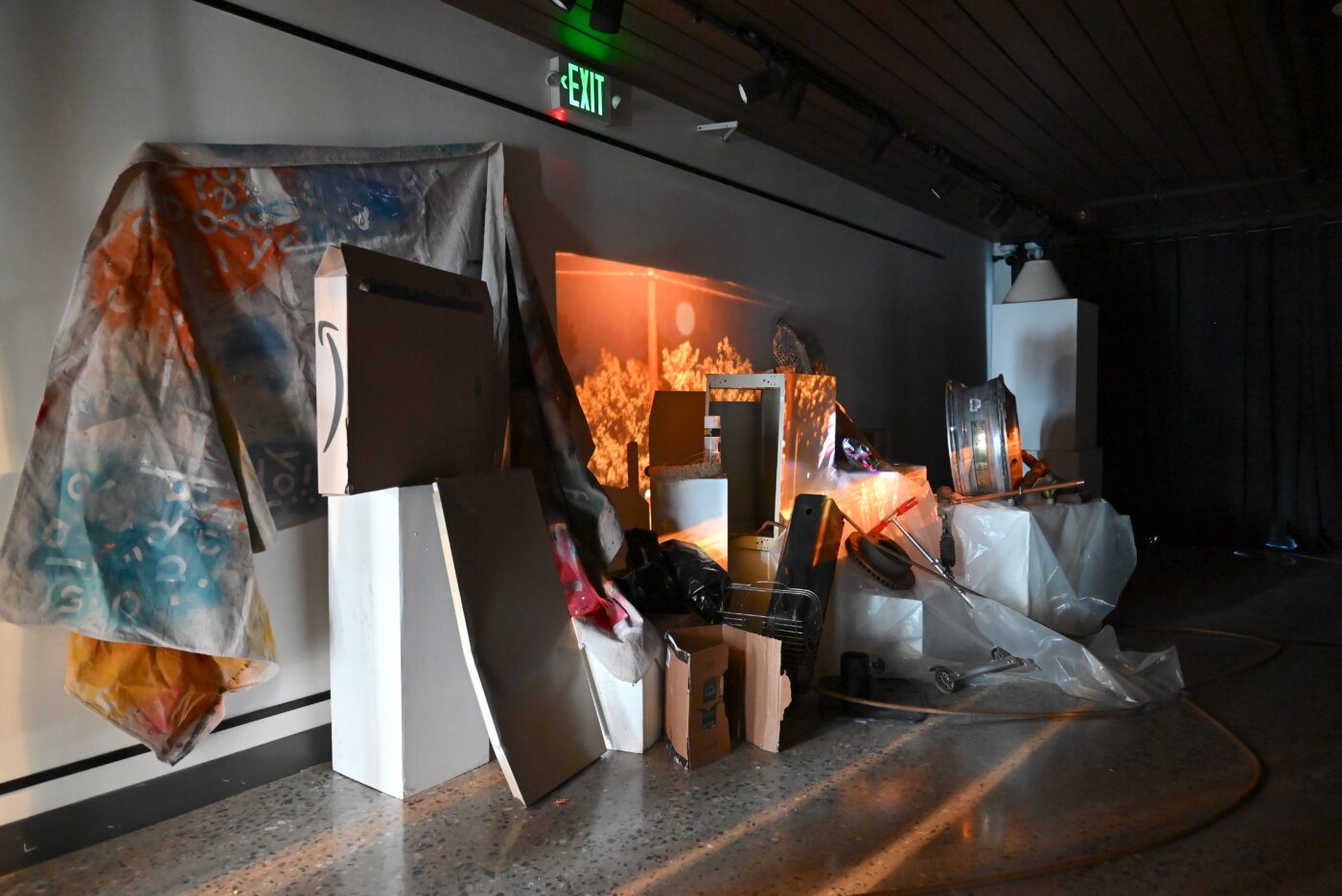
Drawing a contrast between her passion for writing and her early efforts at painting, Hailey Krueger explains, “Stepping into the Portfolio studio for the first time, I considered myself a writer before a painter. I knew exactly what I wanted to do with every word I wrote, but with painting I wasn’t so sure. I didn’t have any big statements I wanted to make, nor did I have one specific style I was conscious of. I simply liked to paint made-up characters I thought were interesting or places I would like to step into and live for a while, which is similar to why and how I write. So, that is what I have done.”
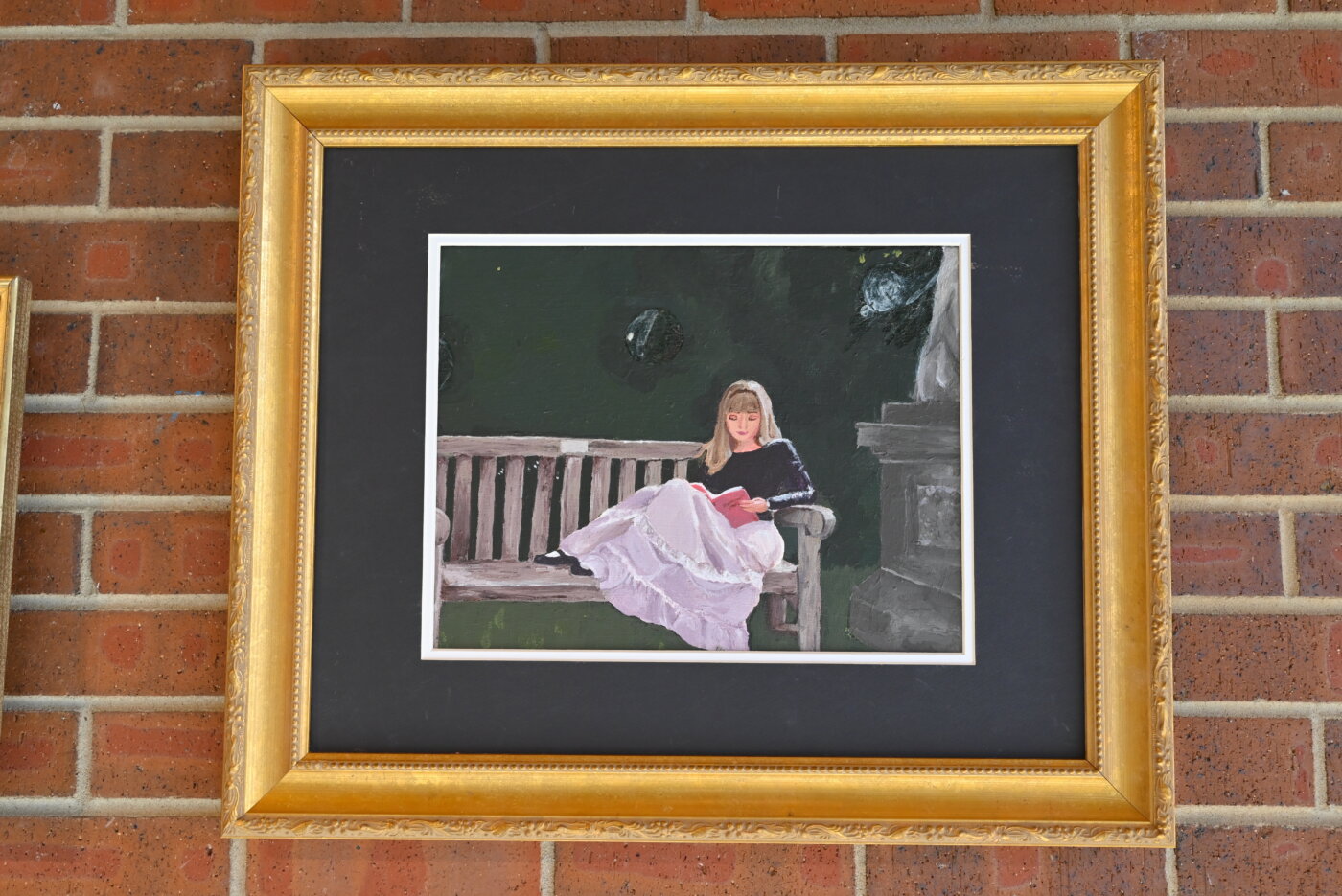
Carter Scott, in his array of works in clay and vinyl cutouts, similarly journeyed through an imaginary landscape to capture images and worlds of his own creation. Quoting the Radiohead song “Fitter happier,” in which a computer-synthesized voice reads lyrics that describe what the “ideal” life is supposed to contain, Scott reflects on the eternal conflict between the artistic impulse and society’s demands for propriety. “No longer afraid of the dark or midday shadows / Nothing so ridiculously teenage and desperate / Nothing so childish / At a better pace / Slower and more calculated / No chance of escape / Now self-employed / Concerned (but powerless) / An empowered and informed member of society (pragmatism not idealism).”
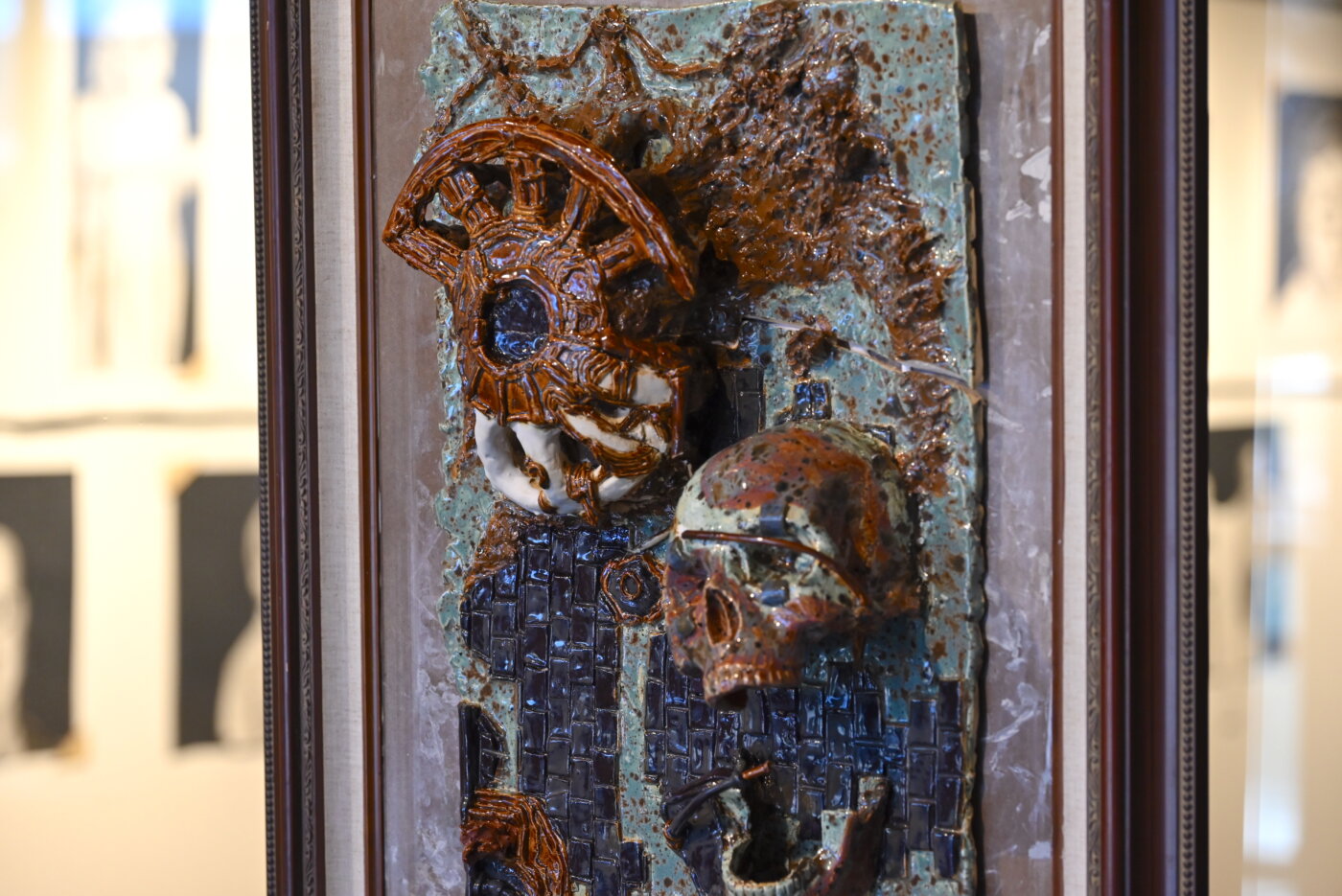
Reconsidering family
Like several of his fellow artists, ceramicist Hudson Watters found the Portfolio program prompted a new understanding of his family. “My family is oddly artistic. Almost everyone in my family can draw or paint effortlessly. At a young age I would try and keep up with my siblings and their artistic skills, but I always fell behind. … That all changed when I took my first ceramics class. I had finally found something that I was good at. … Another reason I love ceramics is the connection I feel with my Japanese heritage—something I don’t get to feel very often in my everyday life.”
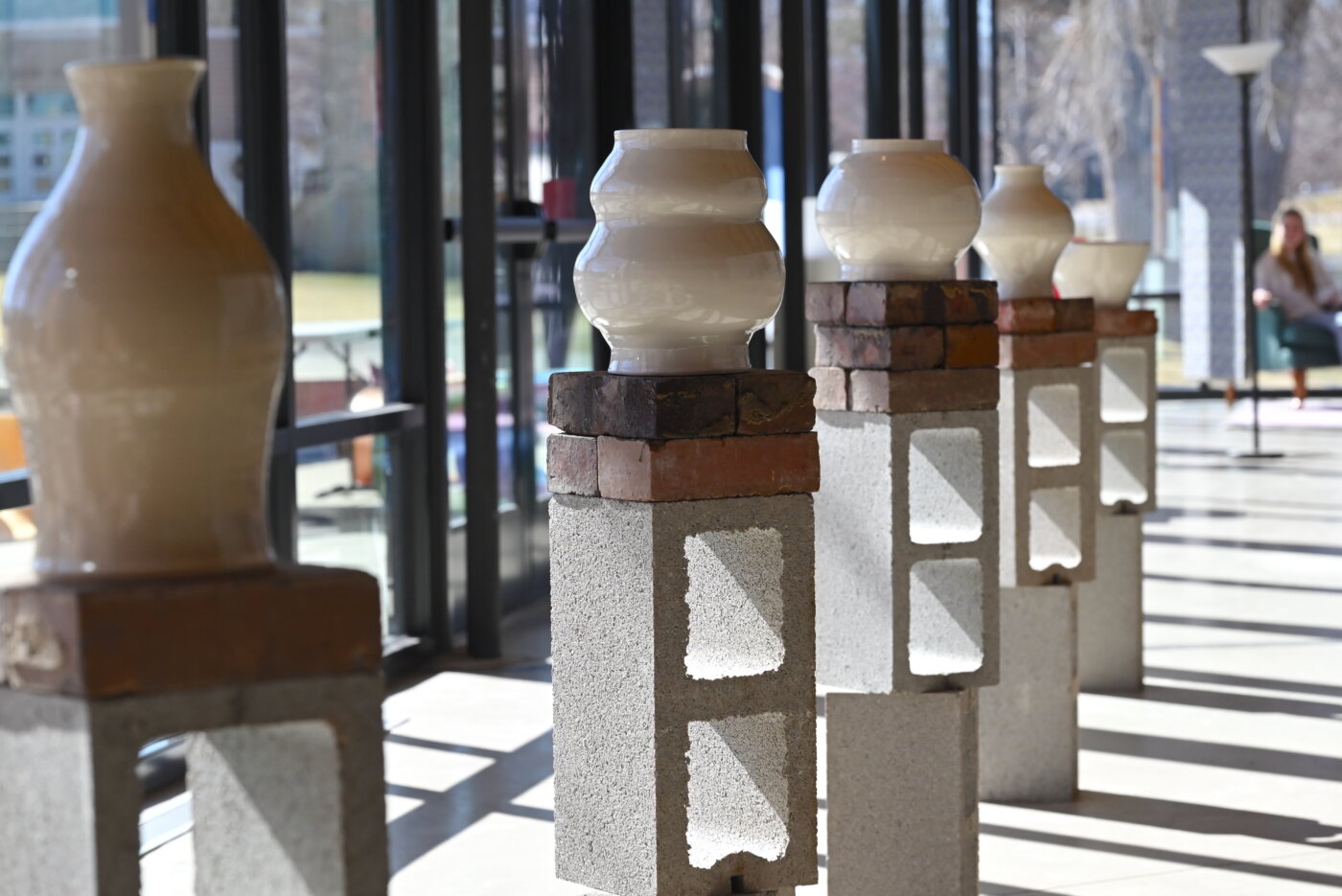
Yaris MontesDeOca-Desiderio’s own family memories turned out to provide the essential inspiration for her art. “While conceptualizing what I wanted my Portfolio exhibit to be, I was reminded of the little girl I once was. I looked through my family photo albums, examining the grainy images that perfectly captured sweet smiles across my parents’ faces and my crooked pigtails. Right next to the printed photos were random doodles along the margins I had no recollection of drawing. Small hearts and flowers surrounded a picture of my parents, older brother, and I posing in front of our old apartment. Suddenly, the once-forgotten memories came flooding back.”
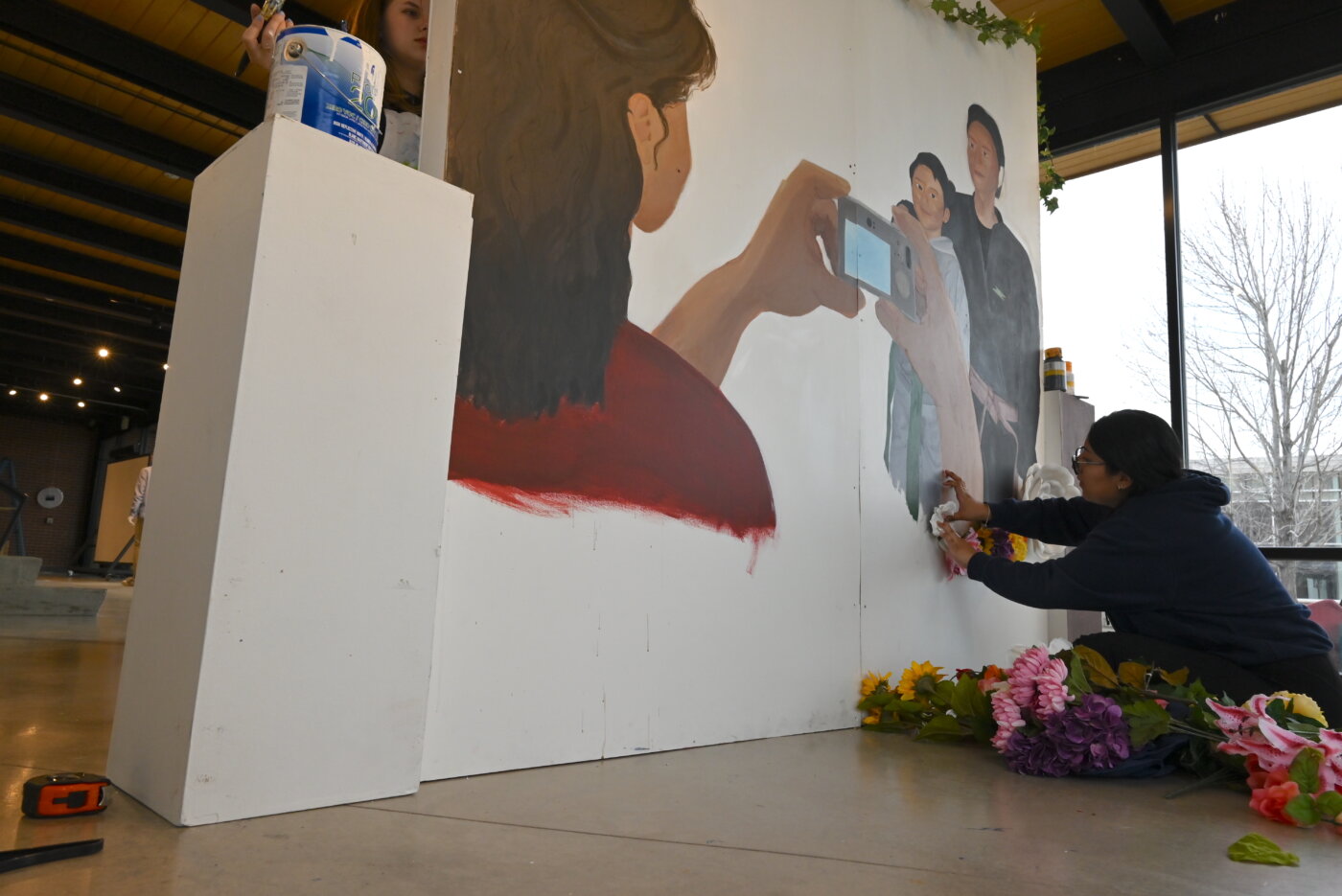
Taylor Slutzky, too, looked to her own life for inspiration after struggling to find her creative footing. “Eventually, I came to the realization that I needed to begin with something I had personally created and build upon it, rather than derive ideas solely from the work of others. That is when I looked through my phone’s camera roll. I chose five pictures from my camera roll representing five different moments over the past few years.”
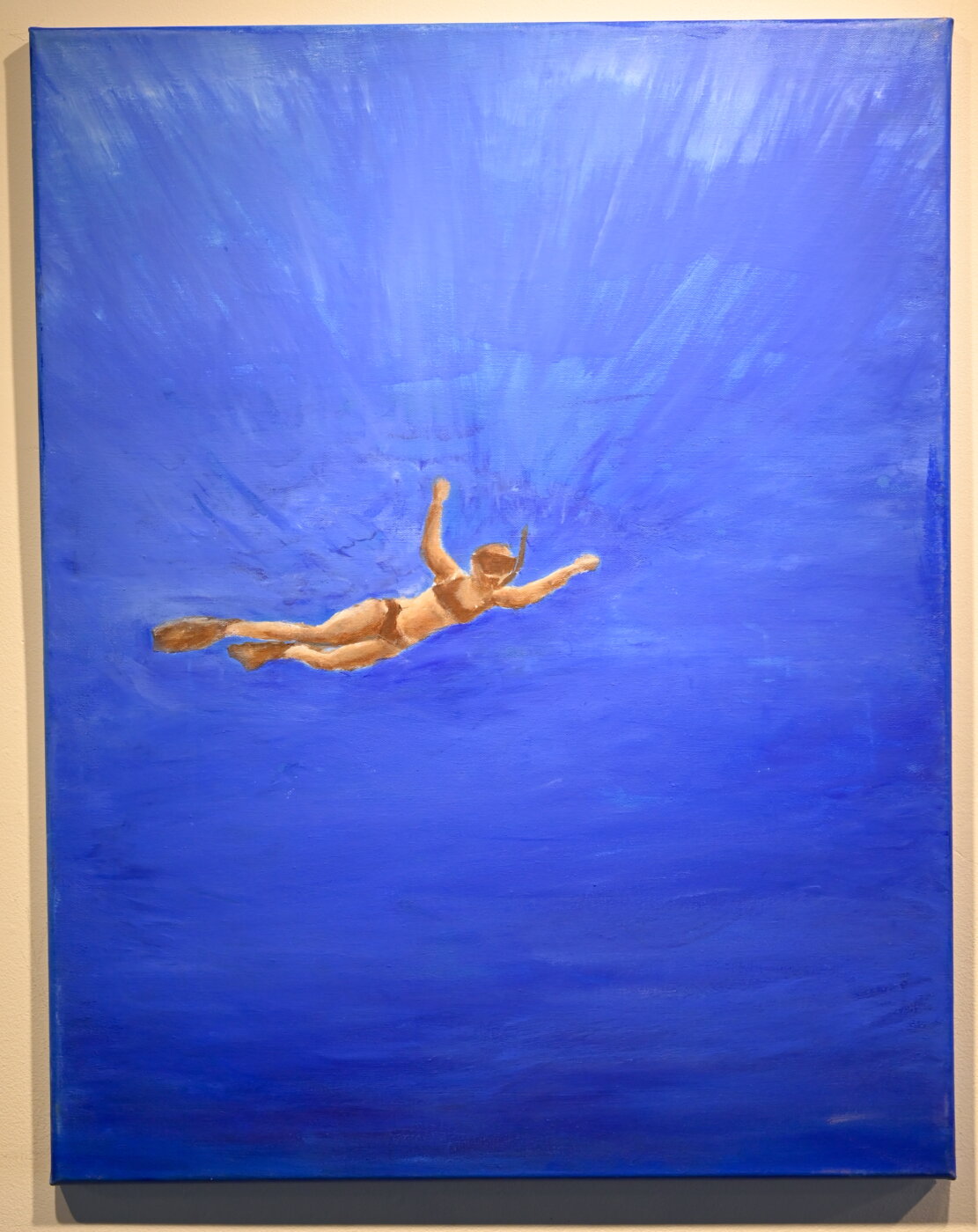
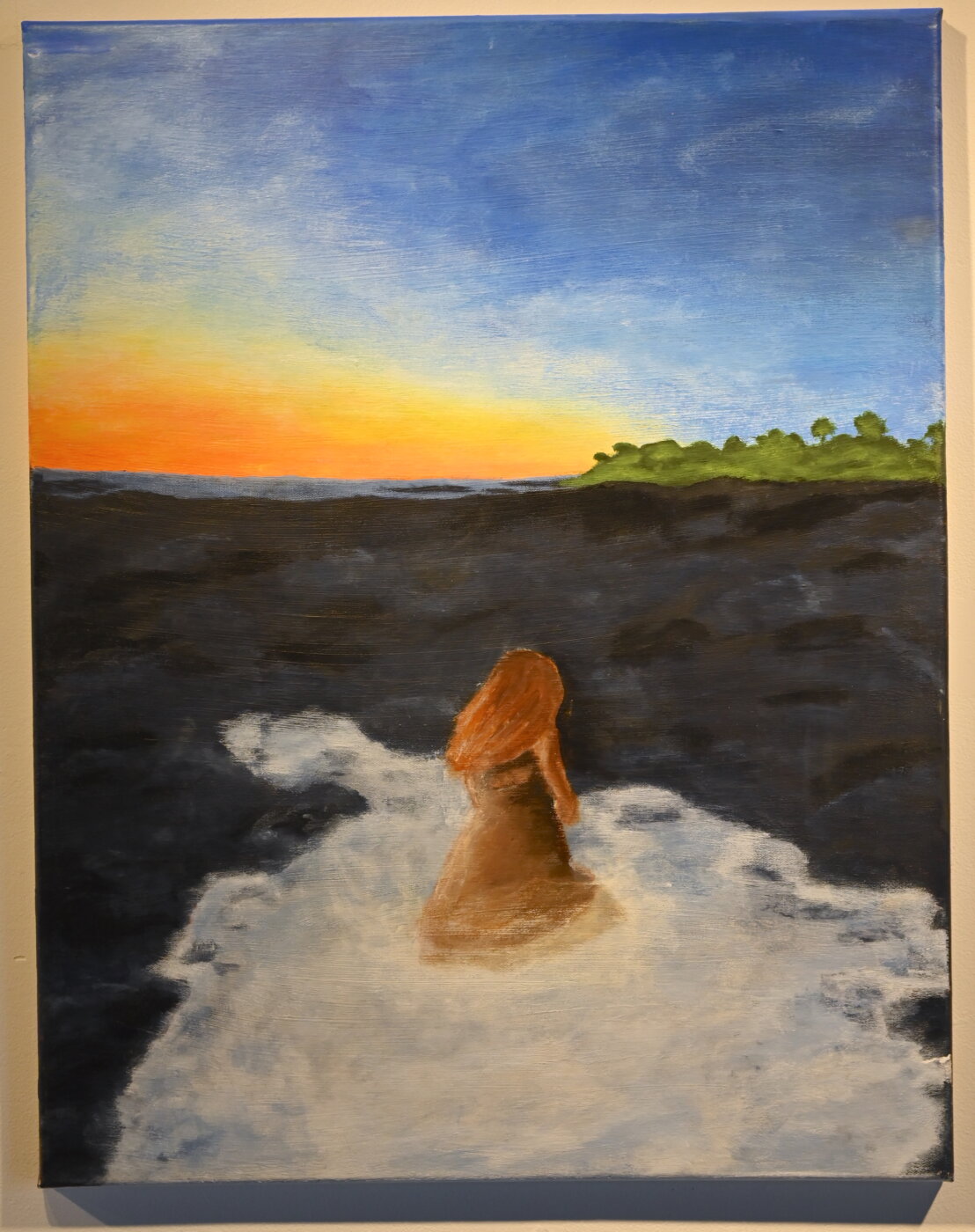
And Violet Tetzeli discovered the passion that would drive her collection of charcoal drawings by exploring the family photographs taken by her late grandmother, Lili. “You feel her in every single image. Her intentionality and love are more tangible than the physical book the images rest within. This was the life of my father and my family through the lens of Lili. I could not be more proud to now present my passion-filled perspective of the stories initiated through her art.”
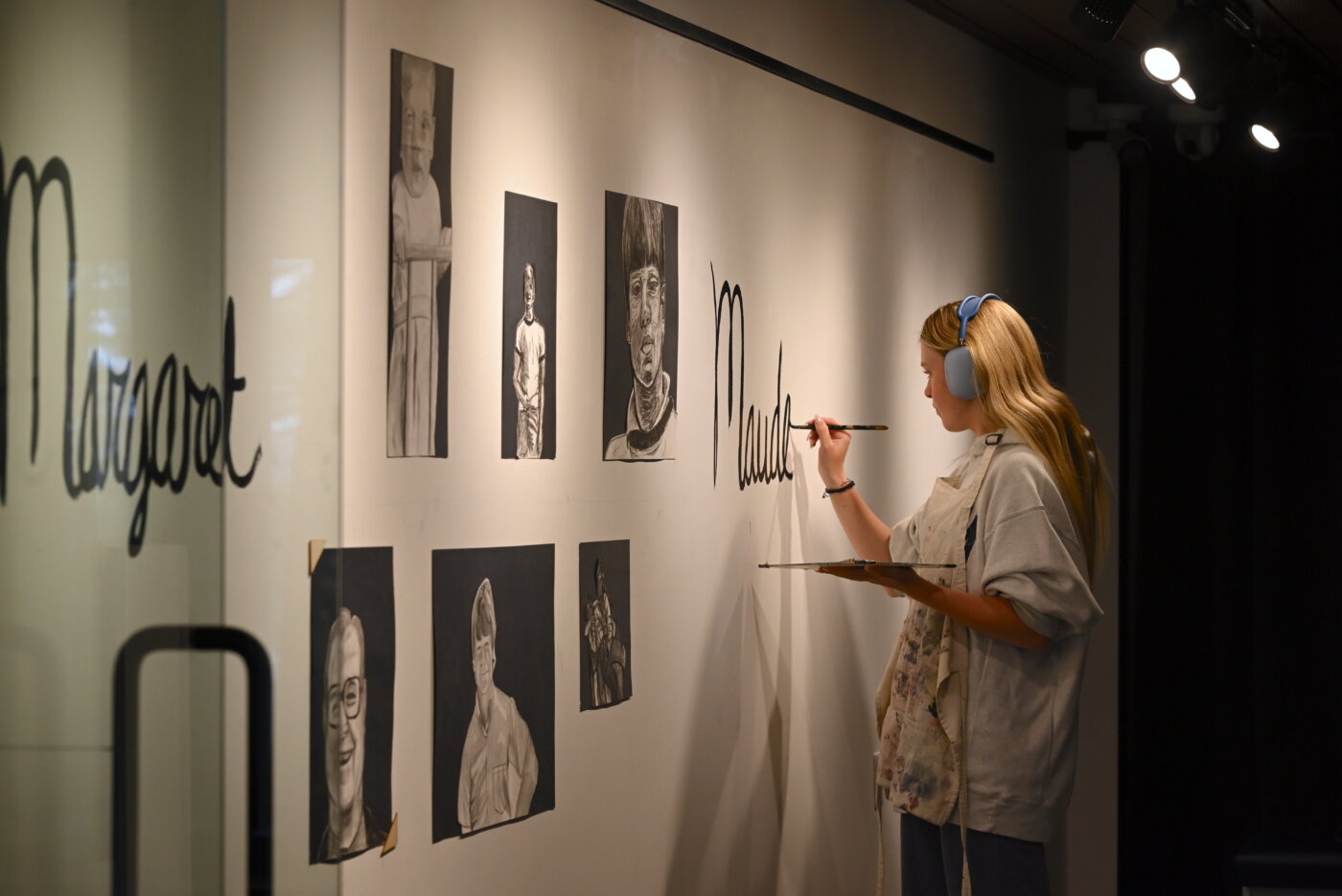
Experimenting with process
For Tess Taplin, Senior Portfolio was an opportunity to “branch out of my comfort zone and discover who I was as an artist. At the start of the school year, I didn’t have an end goal for Portfolio. Not having a detailed and specific plan was overwhelming, but I trusted my gut to create whatever felt right. Because I was trying to come to terms with this new process while also preparing for this show, I found myself making a lot of mistakes. I spent time and created multiple pieces that I did not end up using. However, I now see these pieces as learning points for myself, things that taught me to trust my intuition about how I see art.”
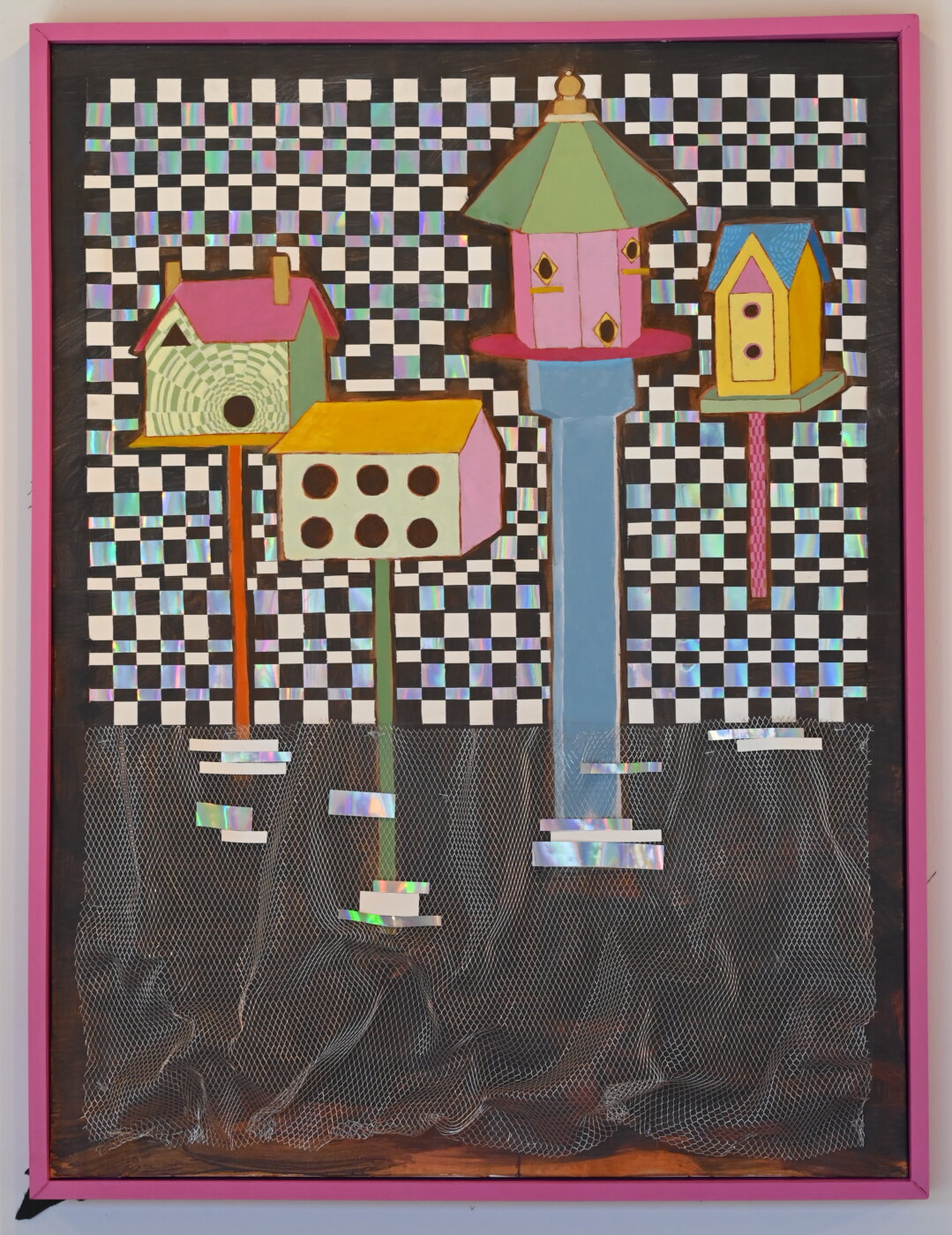
Sam Reisch, who used chemicals and other means to manipulate a series of Polaroid images, similarly describes his Senior Portfolio as a jumping-off point, rather than an end in itself. “So much of making art is being purposeful with what you do, and throughout this process, I challenged myself to back away and let the art make itself. And that’s really what my art here today is about: going with the flow and accepting that not everything in life will always turn out the way you want it to; and when it doesn’t, trying to be satisfied with yourself.”
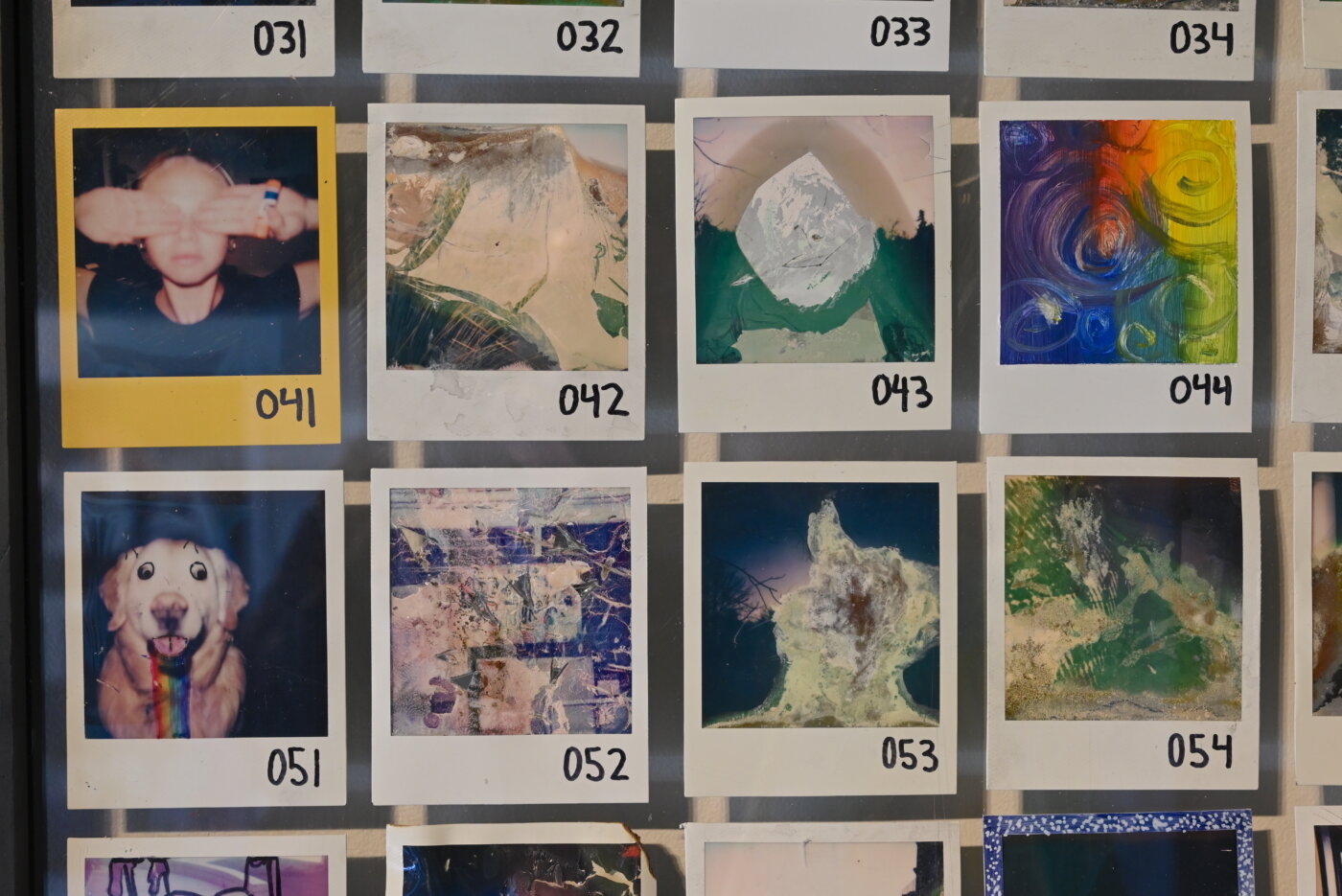
And according to Noah Bub, Senior Portfolio proved an invitation to experiment. “This year I focused on making a new kind of art for myself. Every piece was either a brand new medium or technique from ceramics to shattered glass. This was an awesome challenge for me and so much fun.”
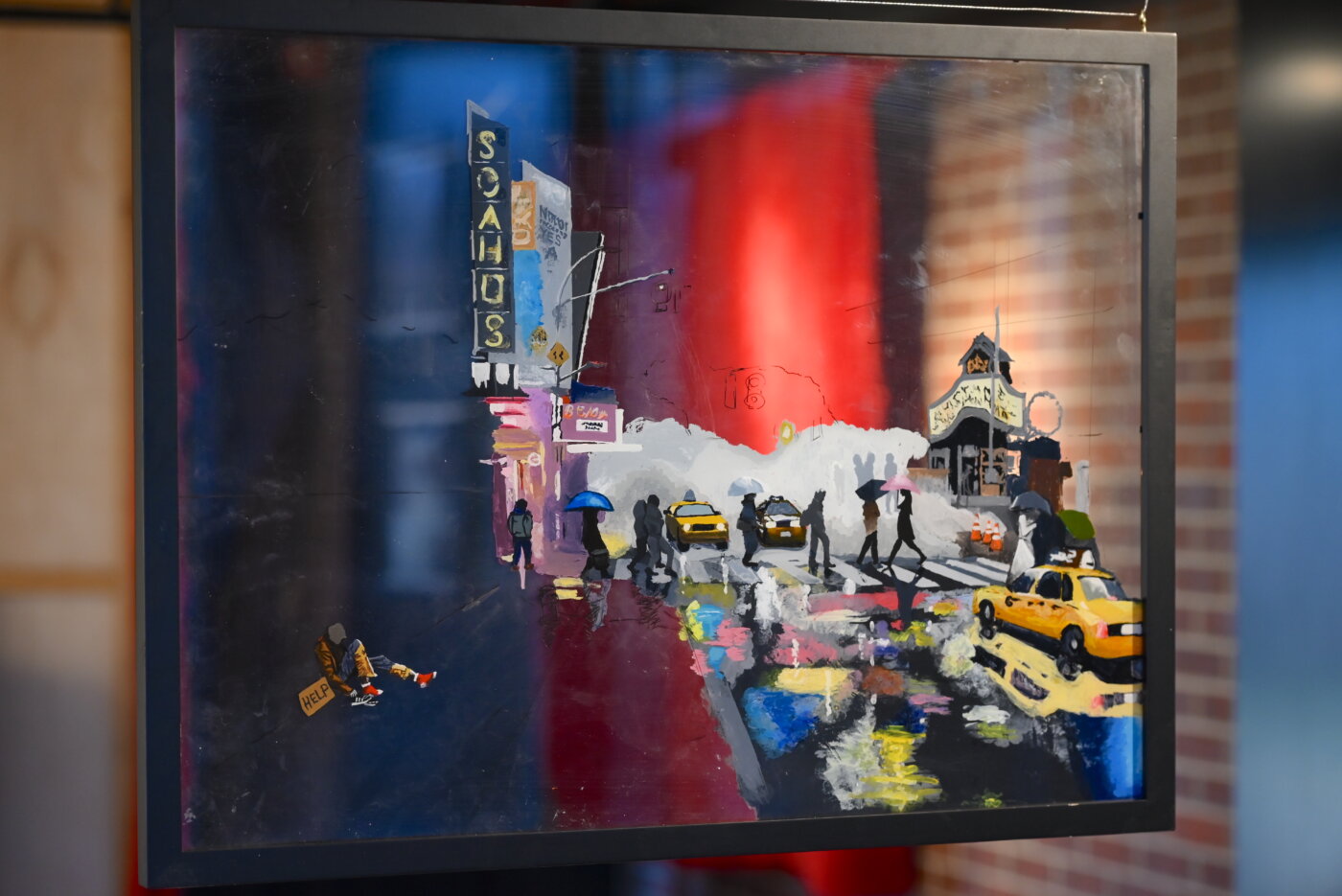
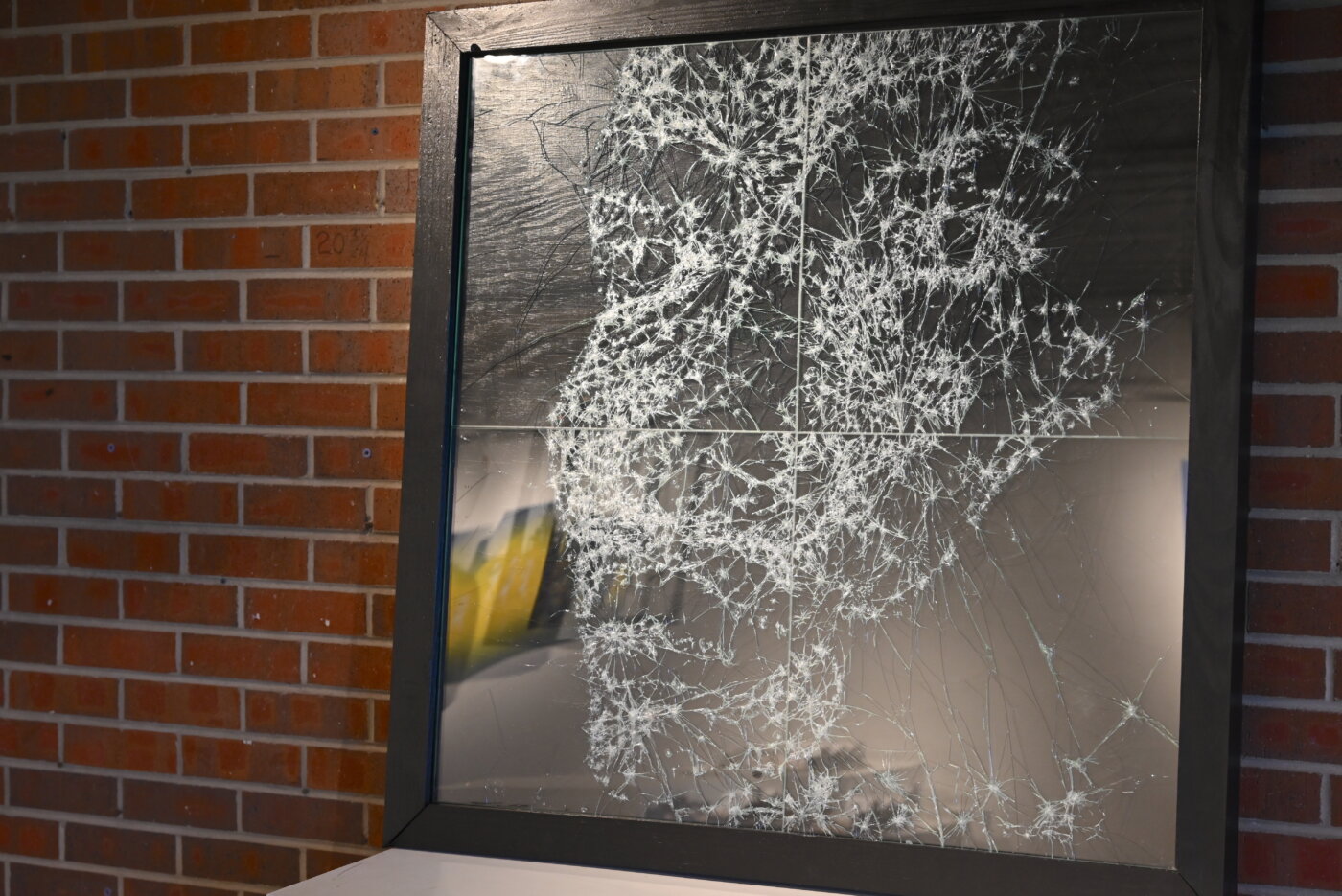
Understanding self
Paige Vahey found the Portfolio process allowed her to make the connection between her art and what is most fundamental about herself—emotion. “I am someone who is very deeply affected by my emotions. As I began ideating and researching my portfolio, I knew I wanted to incorporate certain emotions. This eventually became the basis of my idea, becoming the very thing I wanted to paint. My art is supposed to be a clear depiction of emotion as I perceive it, and the different nuances emotion can portray.”
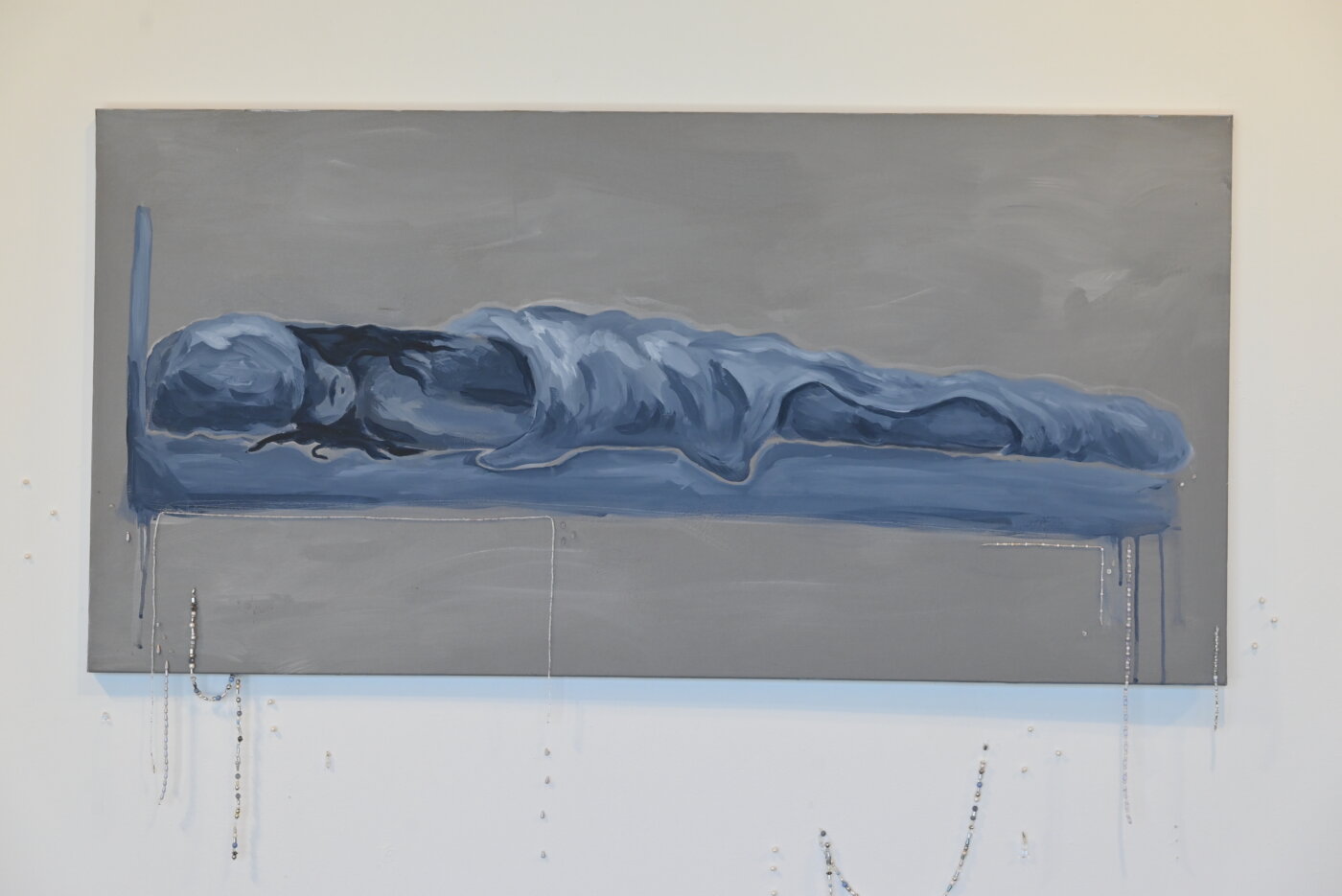
Ezra Wolkon’s final collection of surreal ceramics was a vehicle to explore the realization that “I find comfort in the uncomfortable, relief within the grotesque. I want to turn heads and create an uneasy feeling to those who view my art. I like to focus on the unconventional. I imagine my audience thinking, ‘Do I like this…? No, it’s creeping me out… I must keep looking!’ There are so many aspects that come together to help me induce these responses and emotions.”

Eliza Thorpe writes that her artist’s notebook, on display alongside her paintings, is the most significant symbol of her artistic journey. “It is a perfect representation of how my brain thinks and how I view the world.”
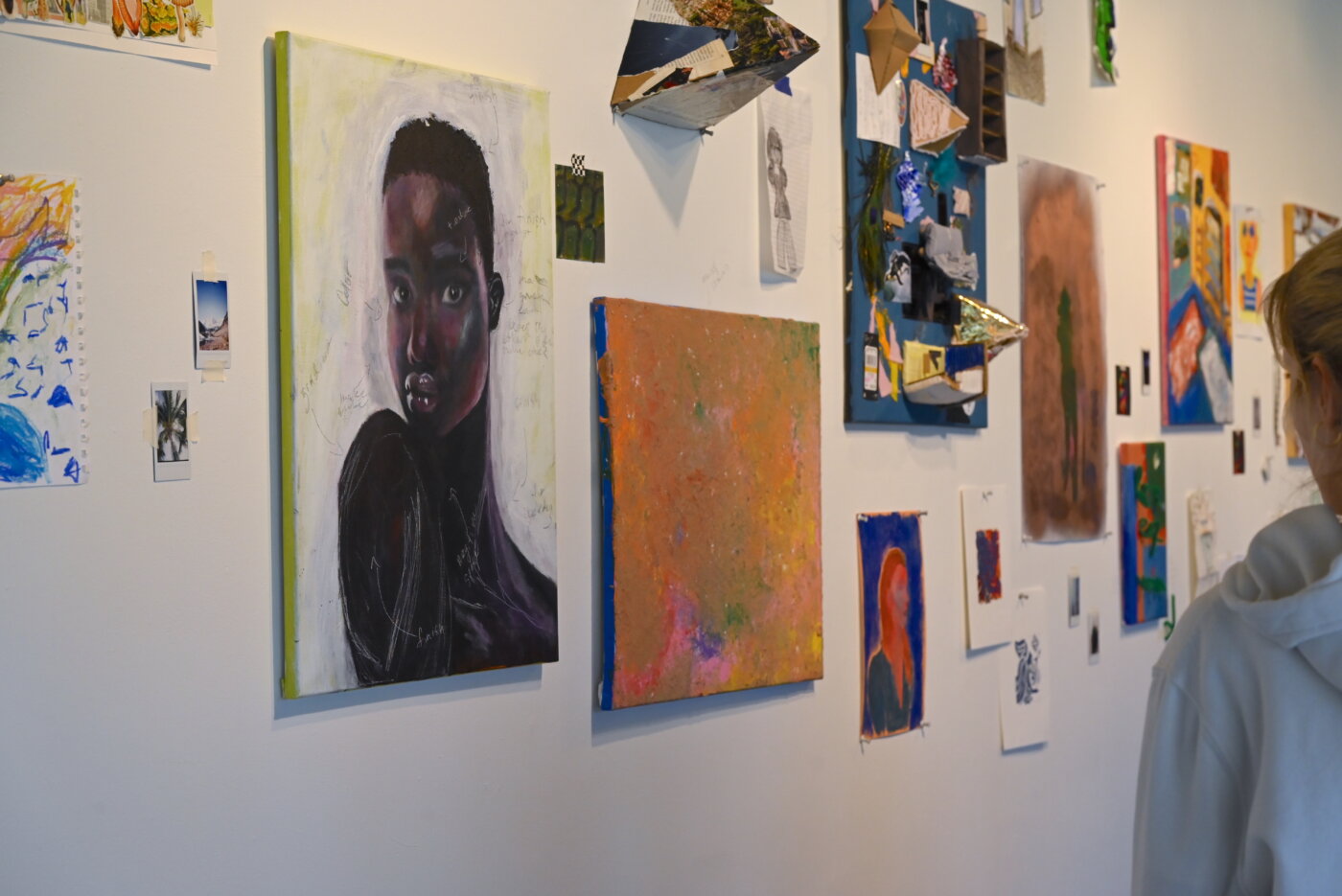
And Avery Siegler explains, “I like to express intimate relationships with people and capture their emotions. I tell a story within a painting and have people perceive the story however they please. I want people to feel something when they look at my paintings. Whether that’s an interior or people in nature, I like to capture the fun and morality of art. I don’t want to be classified as ‘good’ at art or ‘good’ at anything. All that matters is how I feel about what I am presenting and the people around me.”
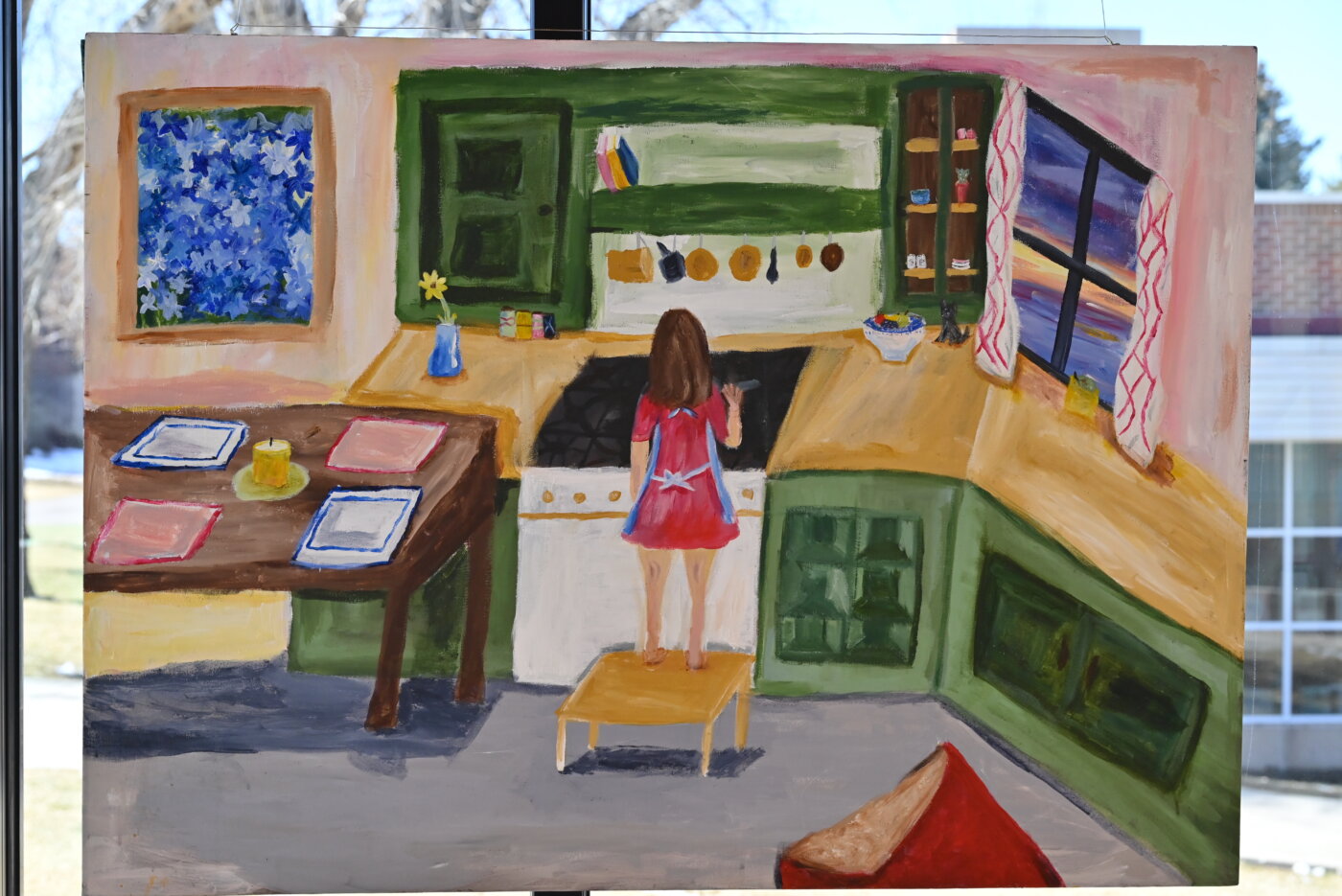
Writing about her street photographs of New York City, Charlotte Corkins acknowledges, “Looking at a city through a small lens opened my eyes to all the tiny in-between moments that we miss as we are caught up in ourselves and obsessed with where we are going rather than what is right in front of us. The occasional middle finger and dirty looks I received were quickly forgotten because of the beautiful moments that encapsulated human connection, self expression, and the beauty of life itself.”
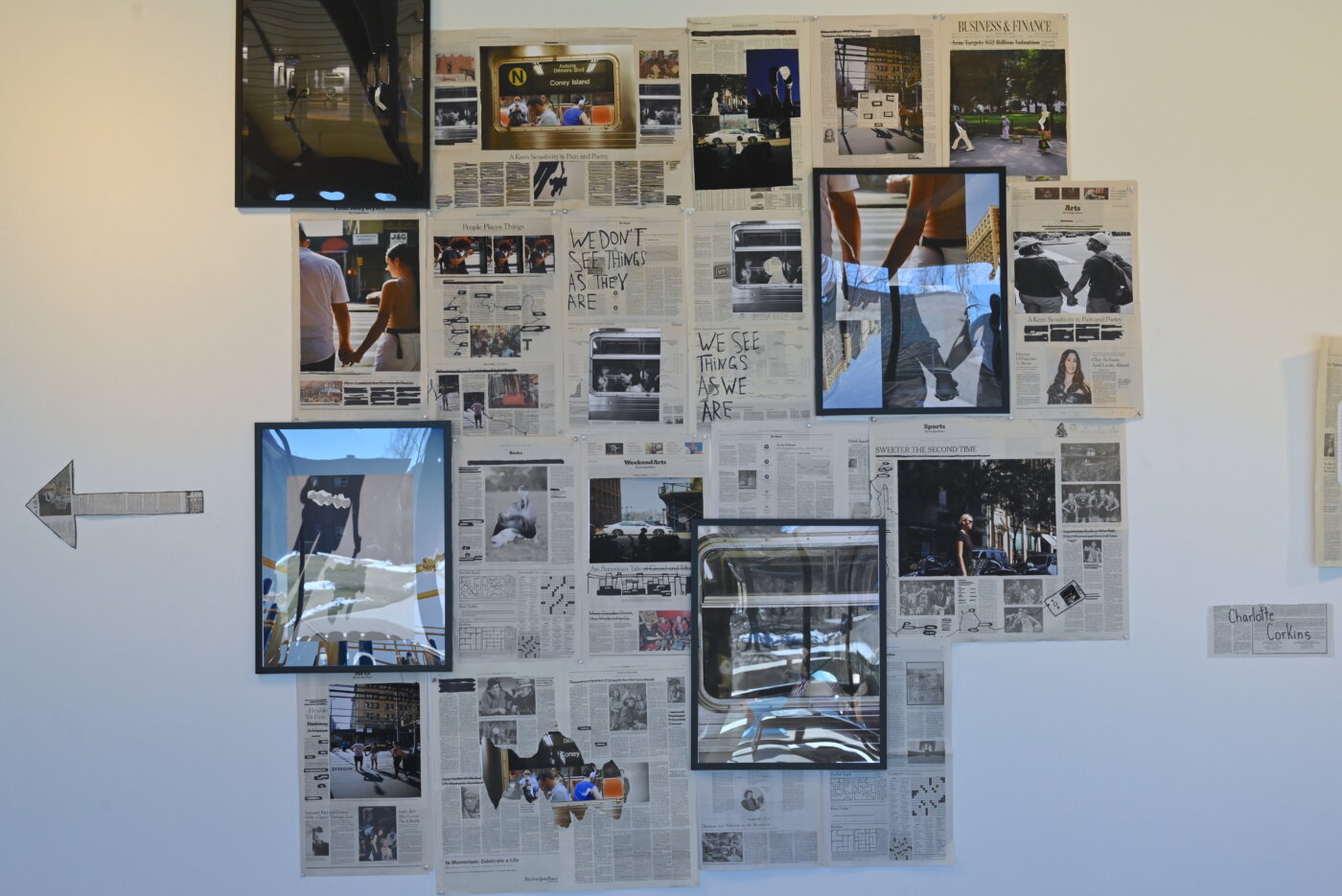
Confronting issues
Fellow photographer Miles Evans writes that in his landscapes he gleaned a different kind of understanding. “With some of my work I traveled to the more industrial sides of Colorado, scouted abandoned structures in the Southern United States, explored the abandonment of many homes, gas stations, factories, you name it. This process has only broadened my philosophical and environmental thinking towards the world we live in, and how humans have polluted the once completely untouched land on Earth.”

Through mysterious images printed on a tarpaulin, Cara Babbs also used photography to explore her concern for the environment. “Growing up in Colorado I have learned to love the outdoors. I have learned to cherish the feeling of being outside and doing the things I love like: skiing, hiking, rafting, fishing, and camping. The idea of climate change is an ominous idea to most; it’s an overarching thing that is drastically changing the world and how many live their lives. It makes the outdoors even more special to me, knowing that they are not going to be the same forever.”
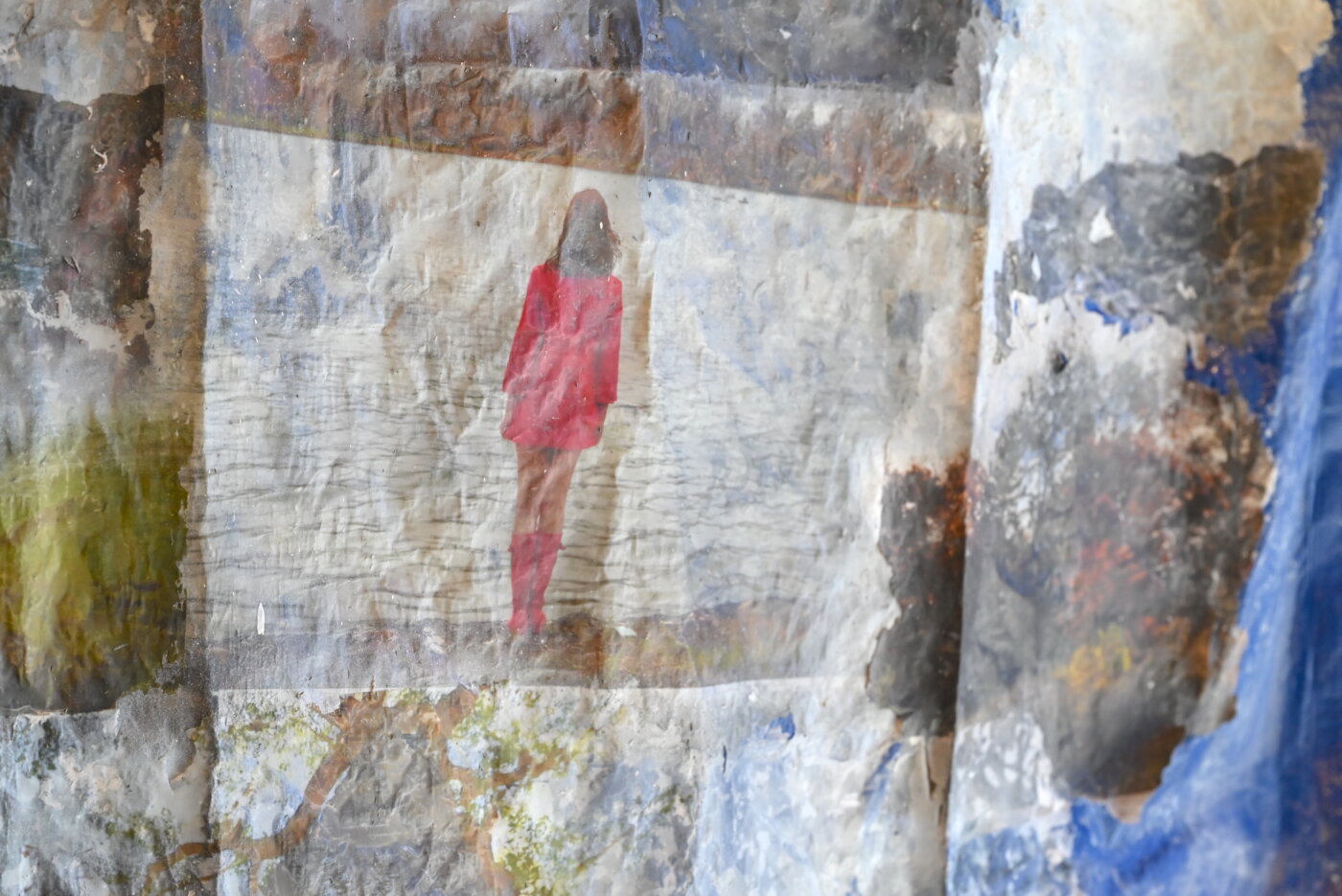
In describing the origins of his multimedia project about Denver’s Westwood neighborhood, Abisai Olivas-Holguin observes, “There are no plaques to tell the story of how the community that I grew up in has been plagued by gentrification. … Gentrification not only displaces families and disrupts community networks but also erases the rich cultural heritage and history of marginalized neighborhoods. … Uncovering this history allows us to acknowledge the voices and experiences of those marginalized and displaced by gentrification, ensuring that their stories are not erased or forgotten.”
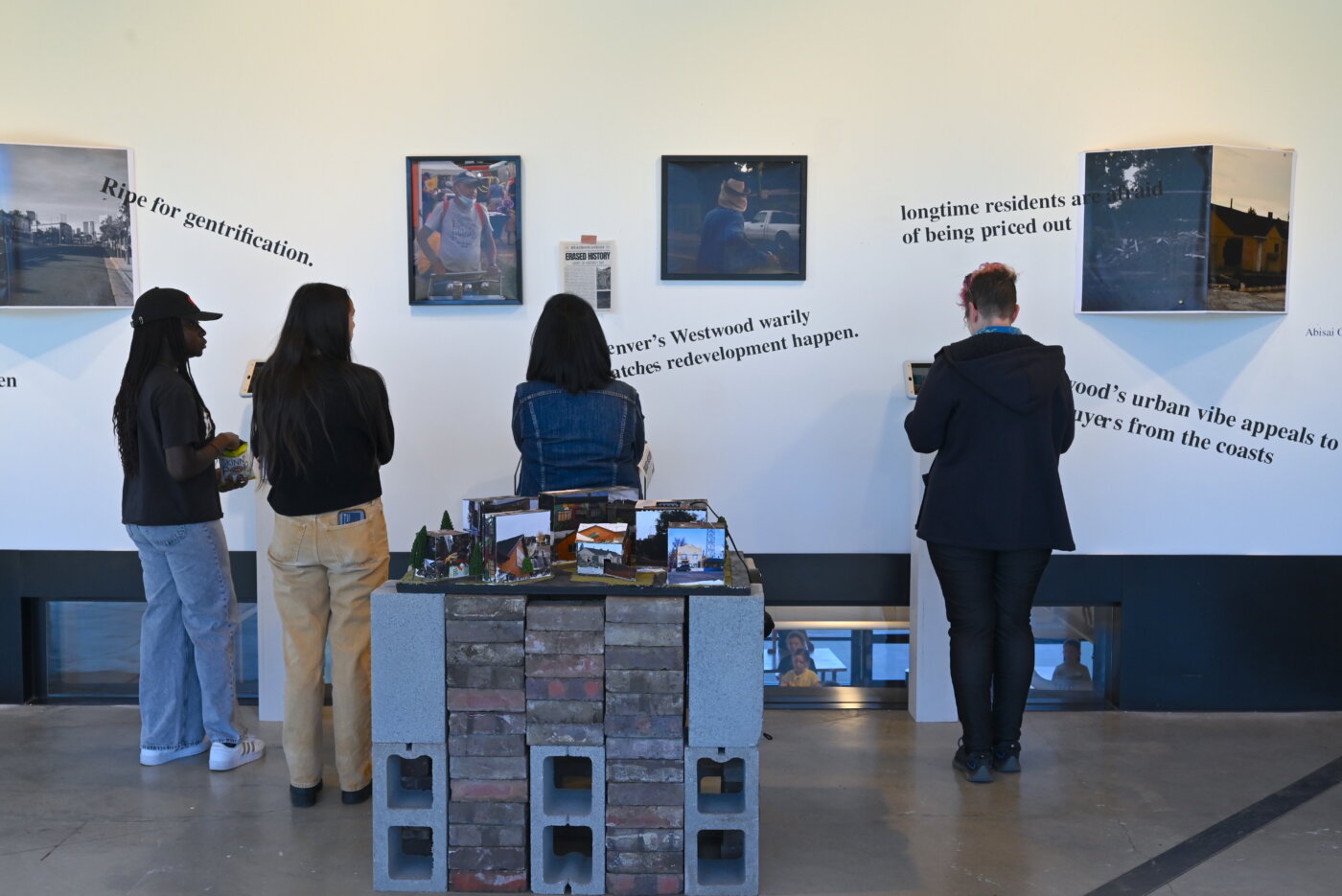
And Eleanor Wynne writes of her collection of paintings, “Girls my age in Indonesia, or the Bahamas, are losing their homes due to earthquakes & flooding. My own friends who live in Boulder fear the summer months because they know, eventually, a wildfire will burn down their neighborhood. I feel like I am slowly being suffocated by the effects of climate change closing in, and it terrifies me.”
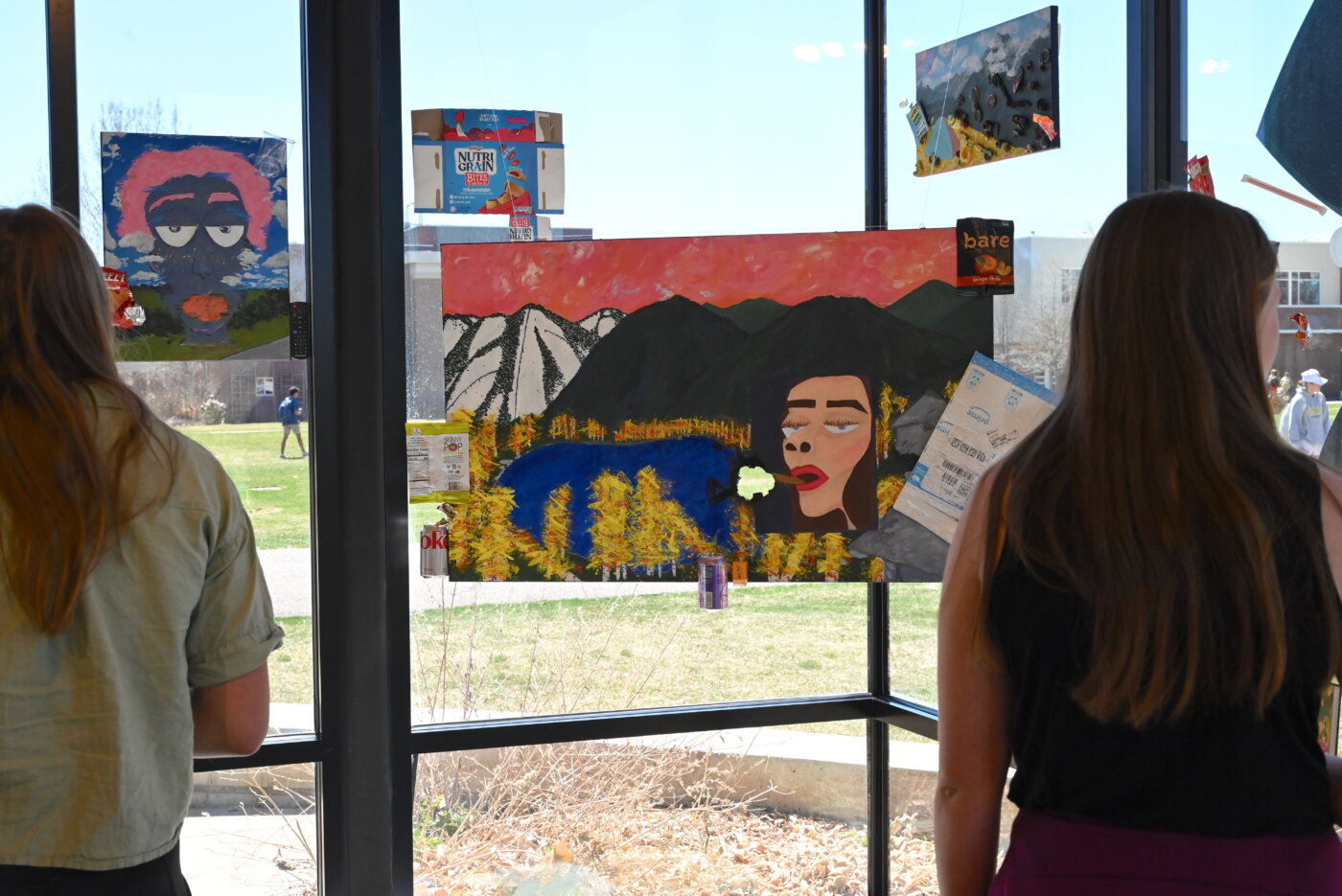
But while some of these creators may have found in their art a vehicle to communicate a serious message, all clearly came to understand the value, joy, and hope nurtured through the Senior Portfolio experience itself. In the words of Alex Miramontes, “My work shows my family. My work shows my words. My work shows the moments that have been stored within me. My work shows me. Through the creation of this project and the creation of myself, despite its mundane redundancy, the phrase ‘Be yourself’ rang out to be the answer. I found beauty in its humble yet ambitious nature. Although exuding simplicity, it unlocks the self. It is both a phrase that represents the acceptance of the current self and the journey of what one is yet to become.”
